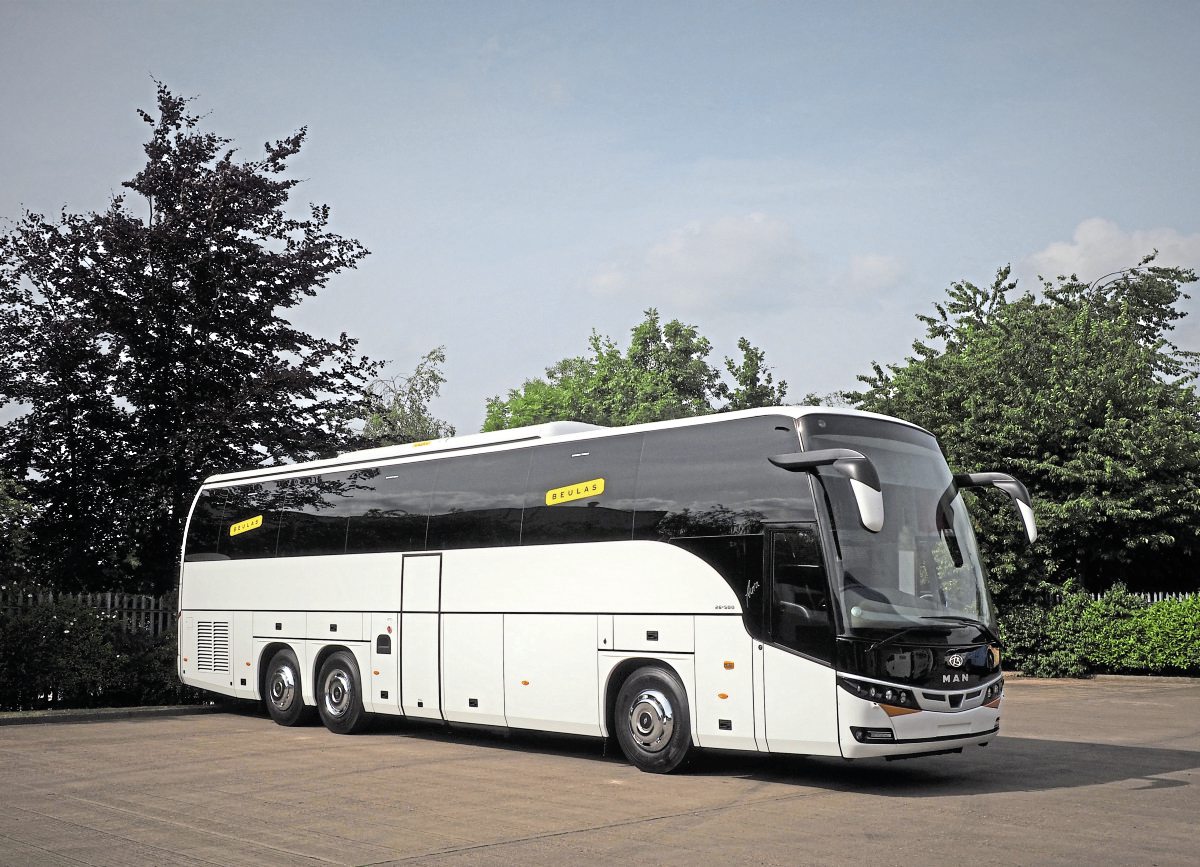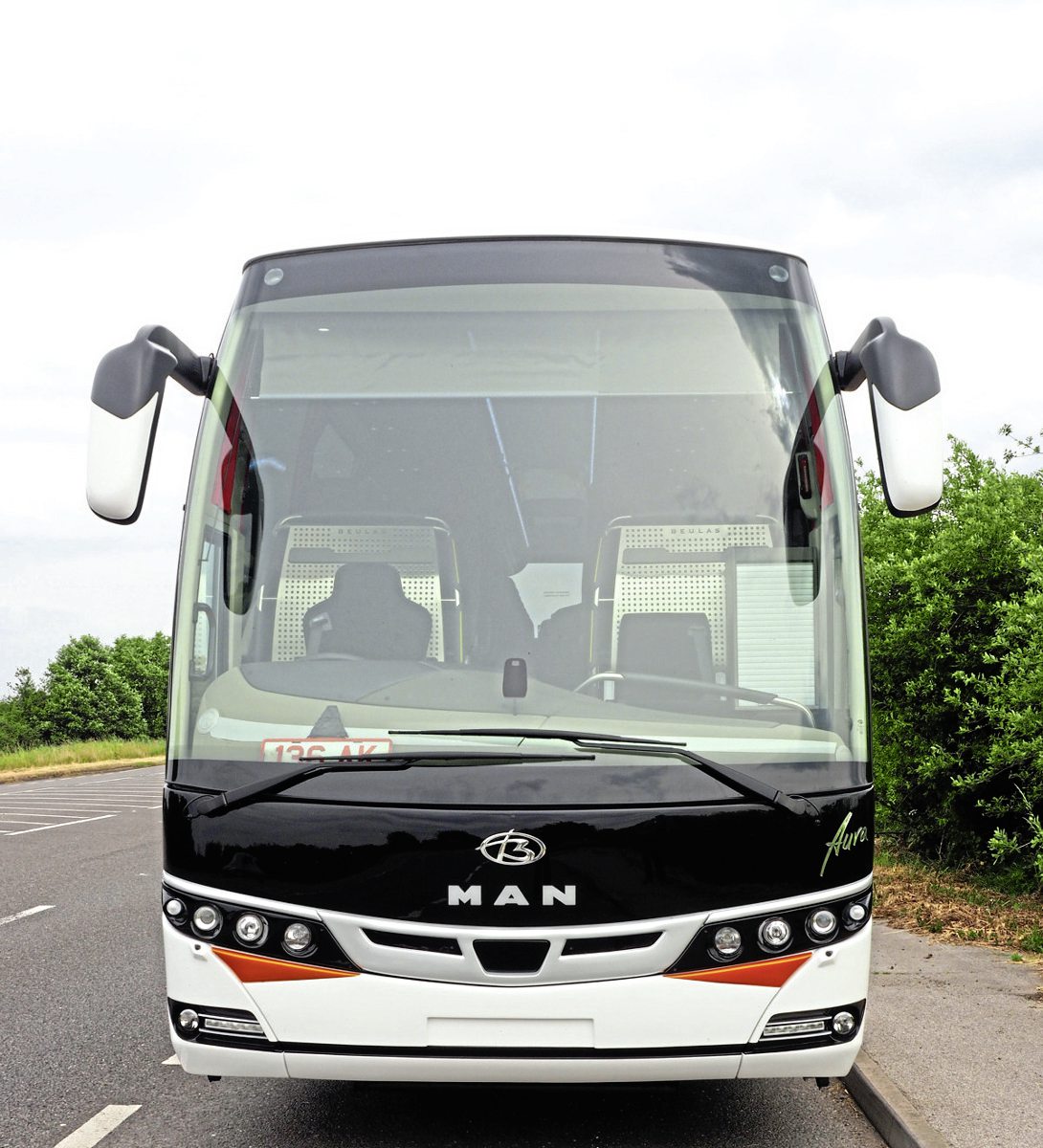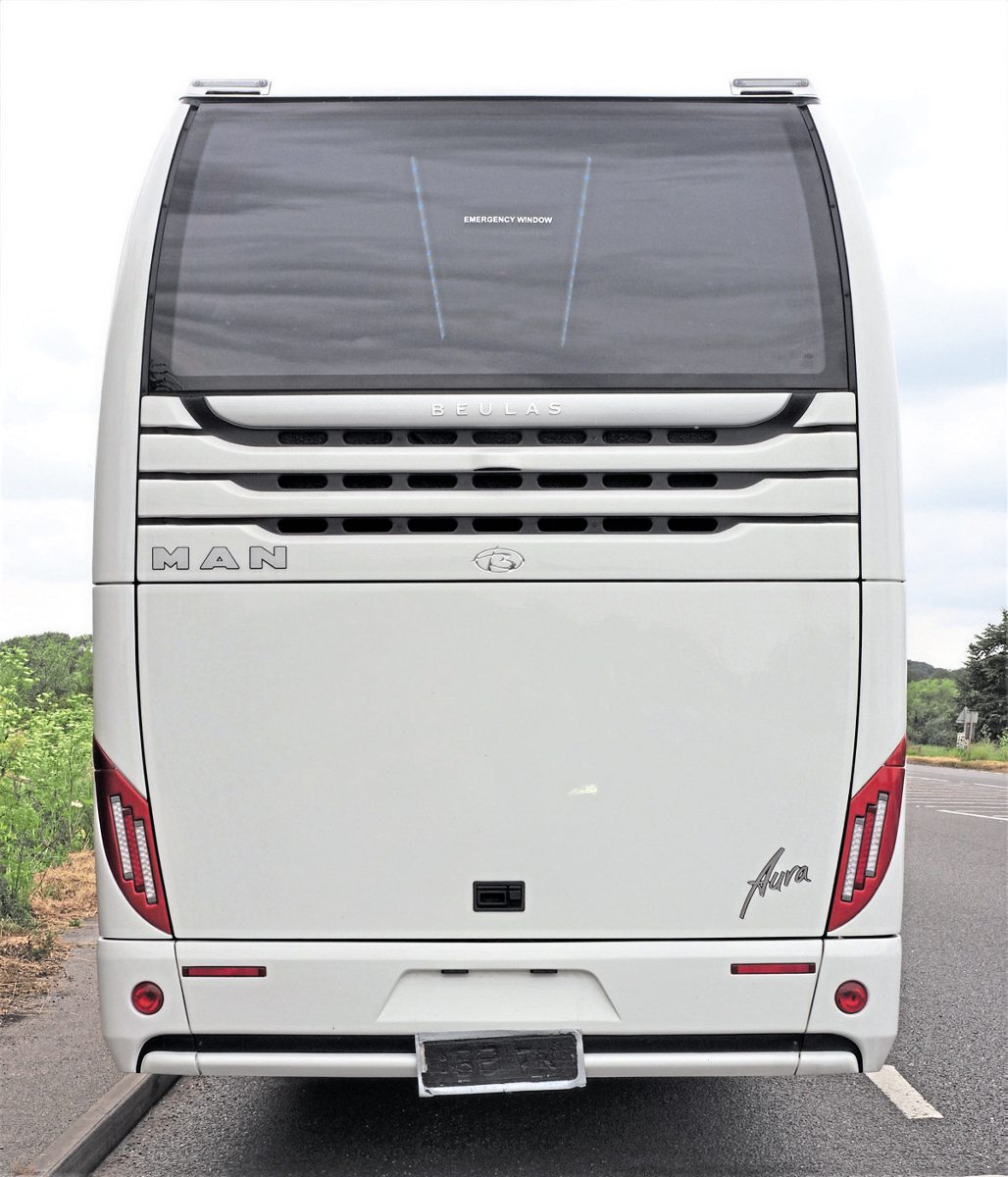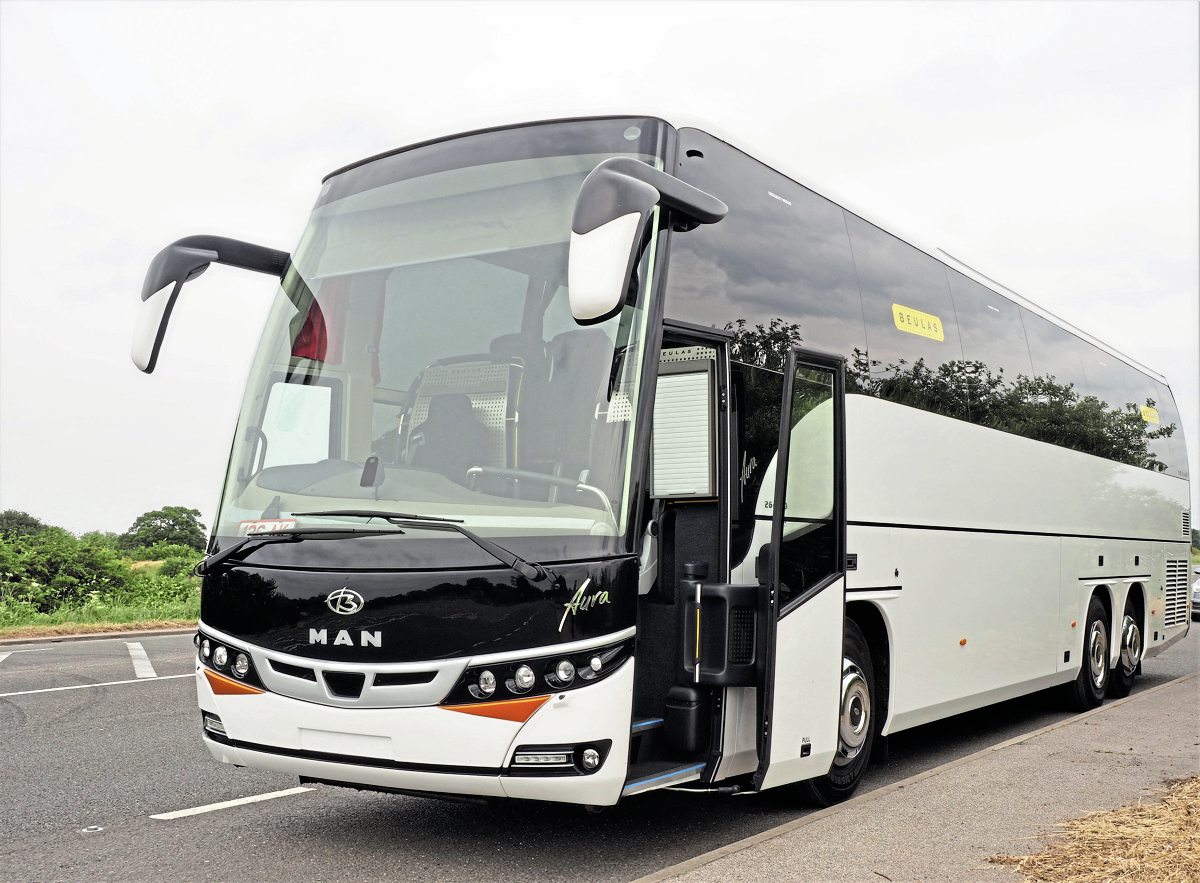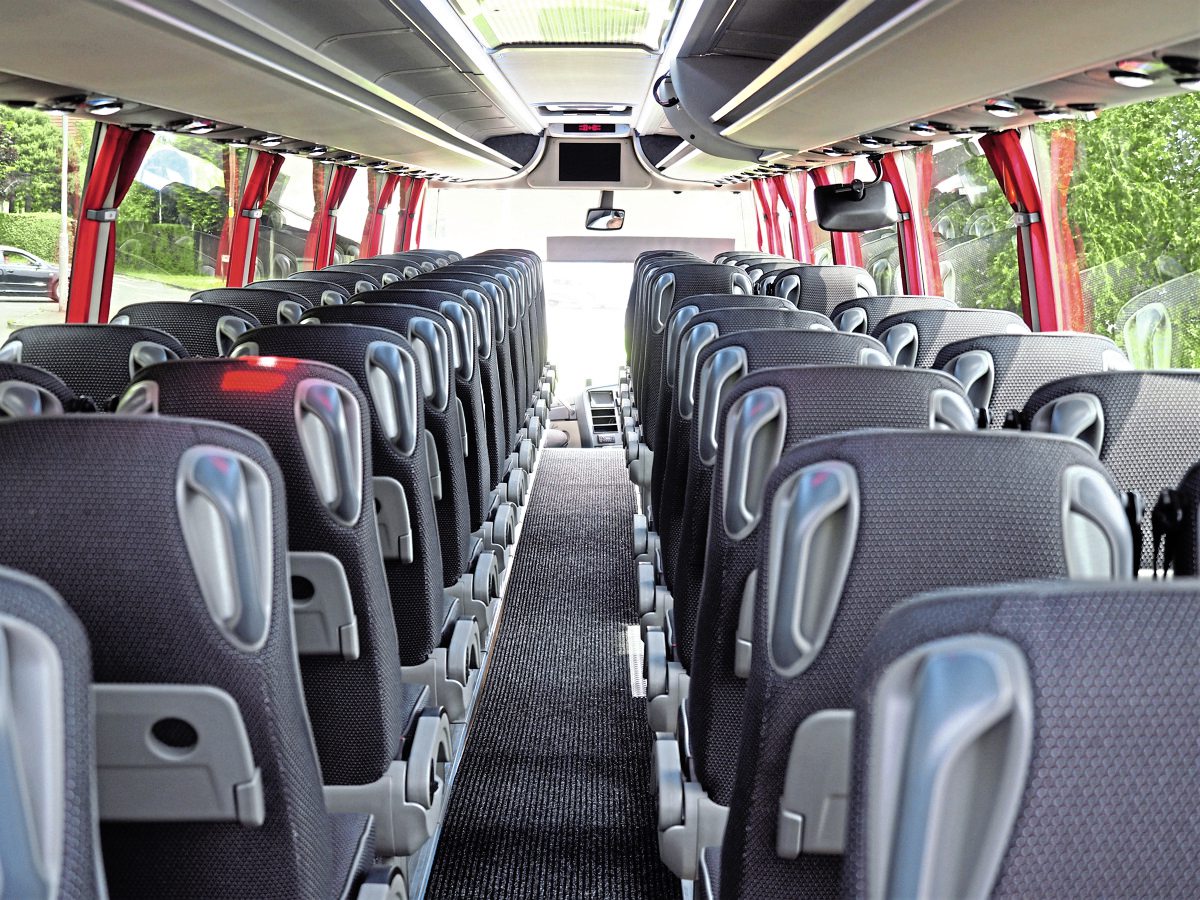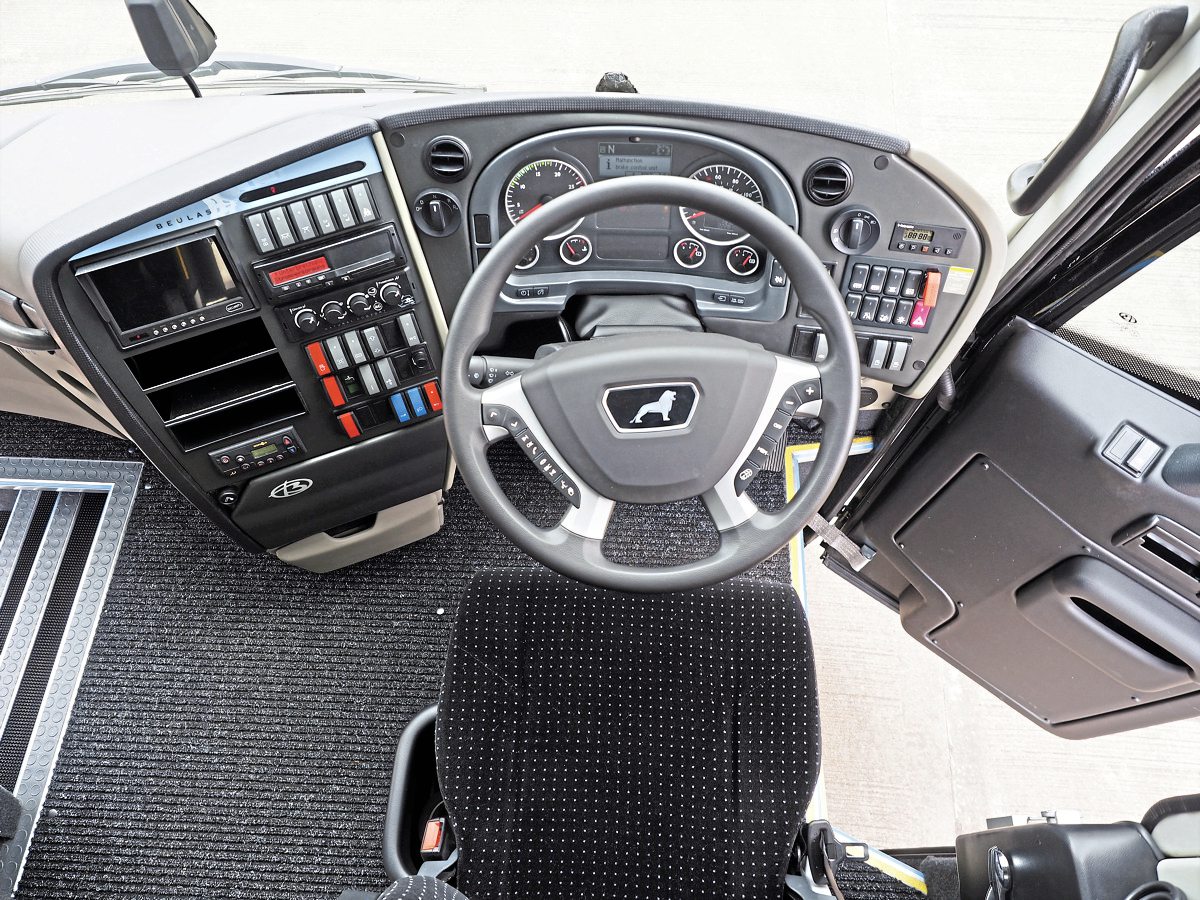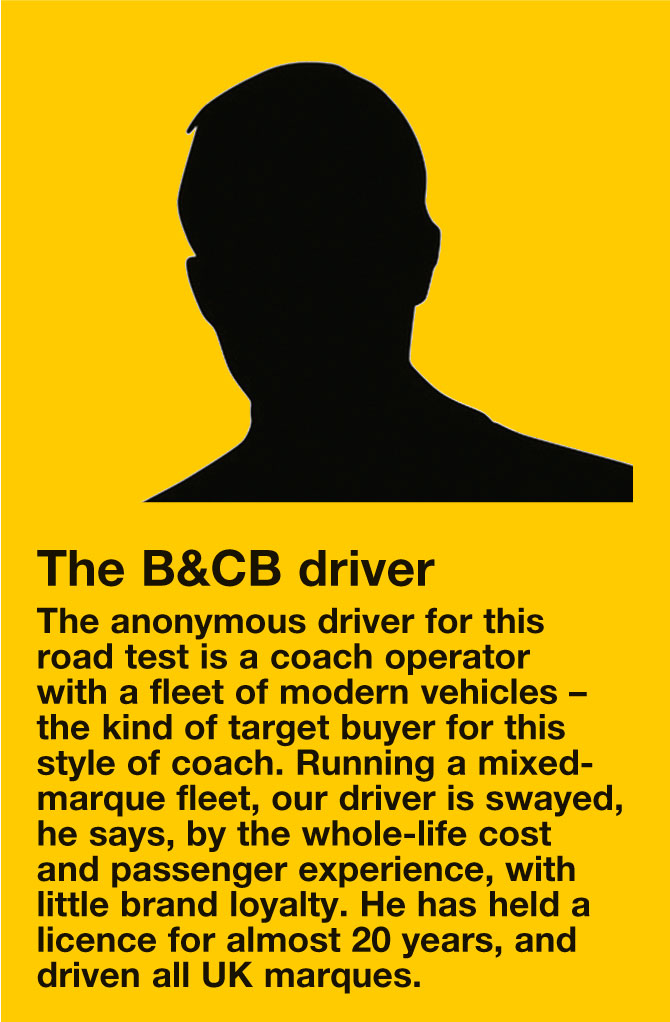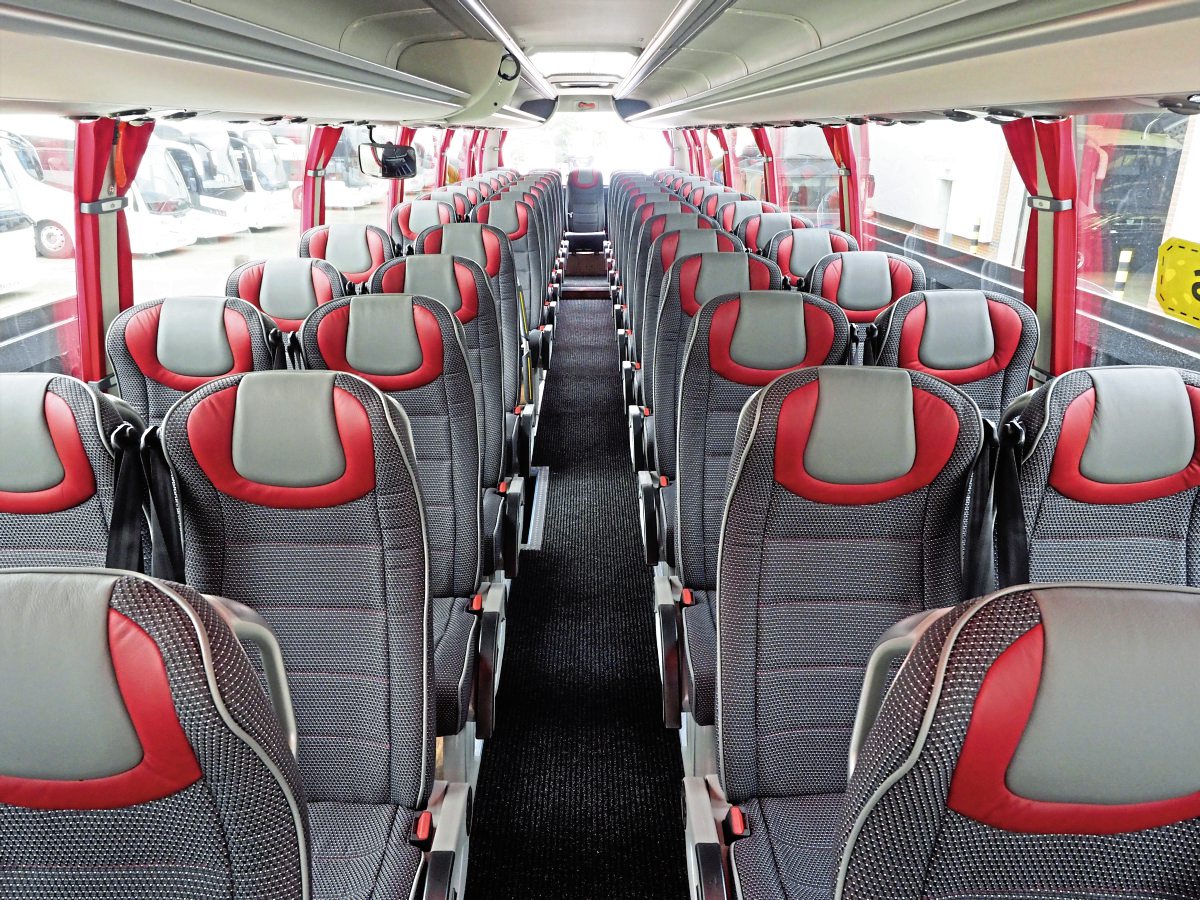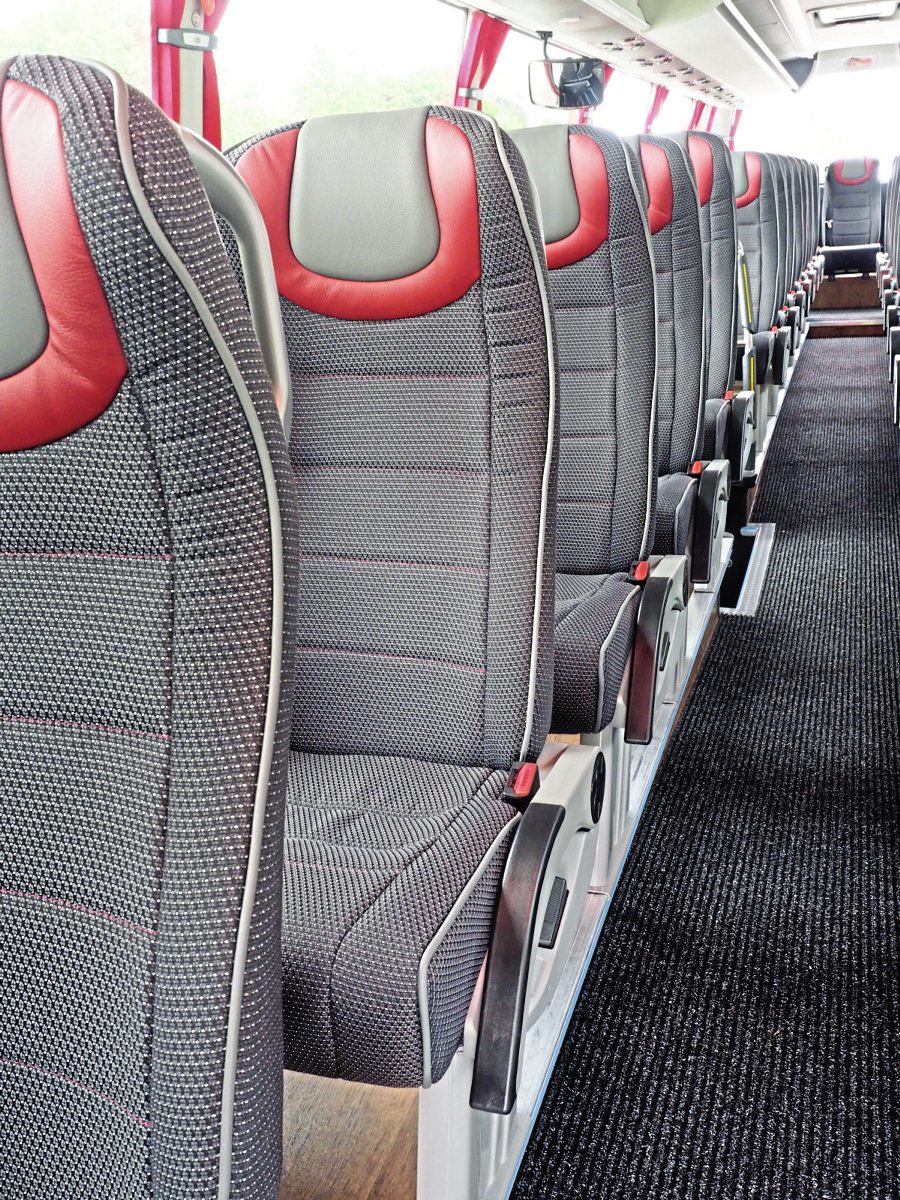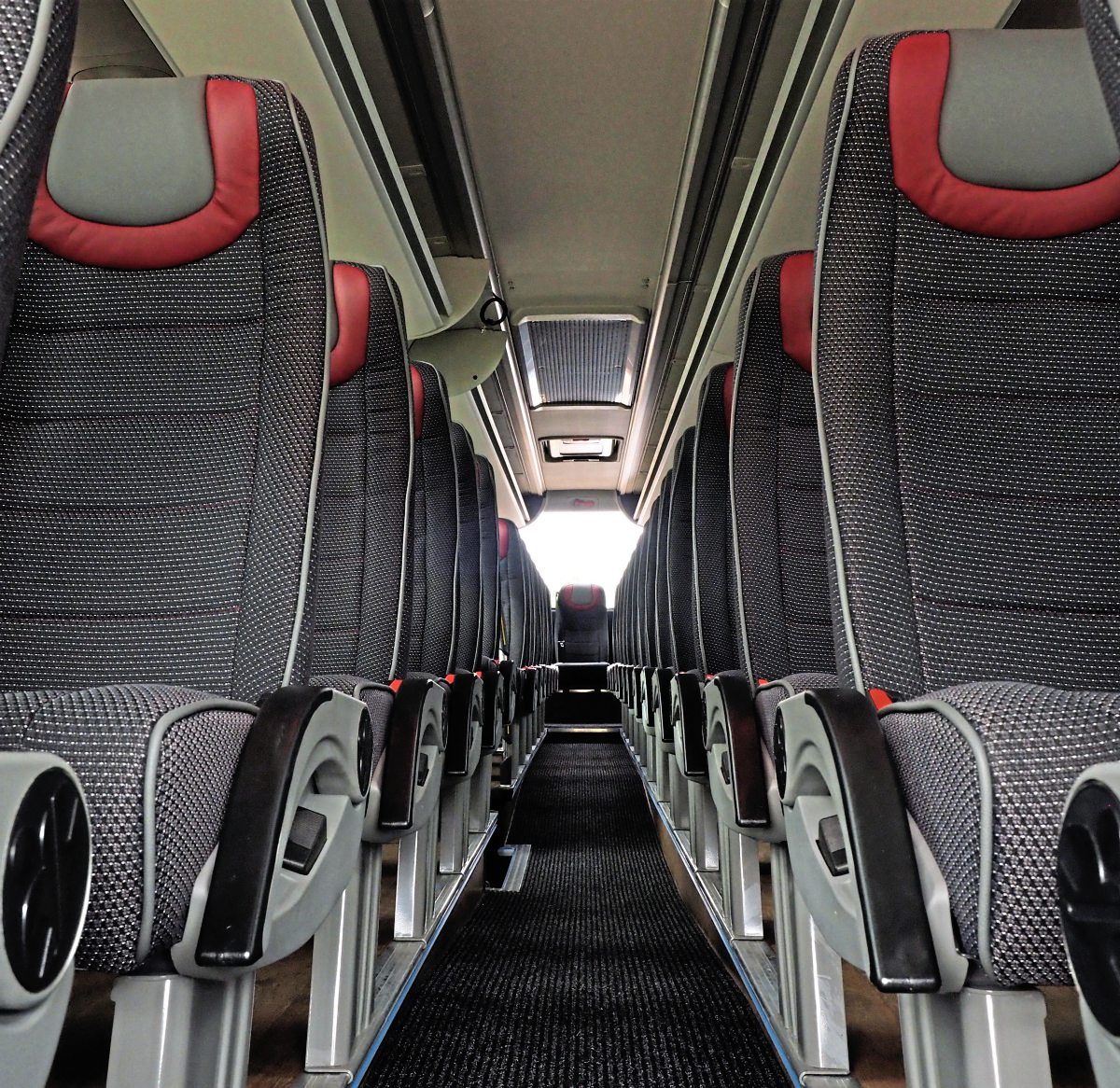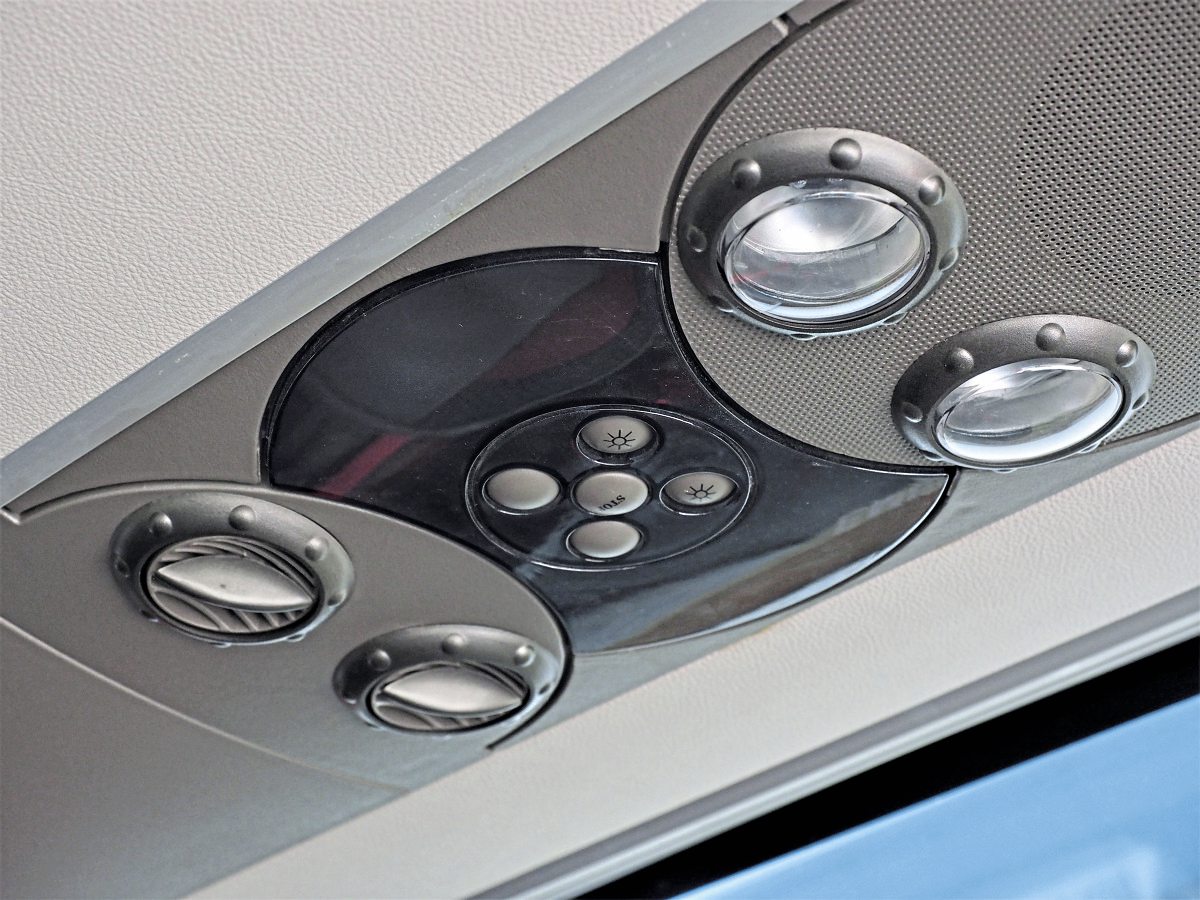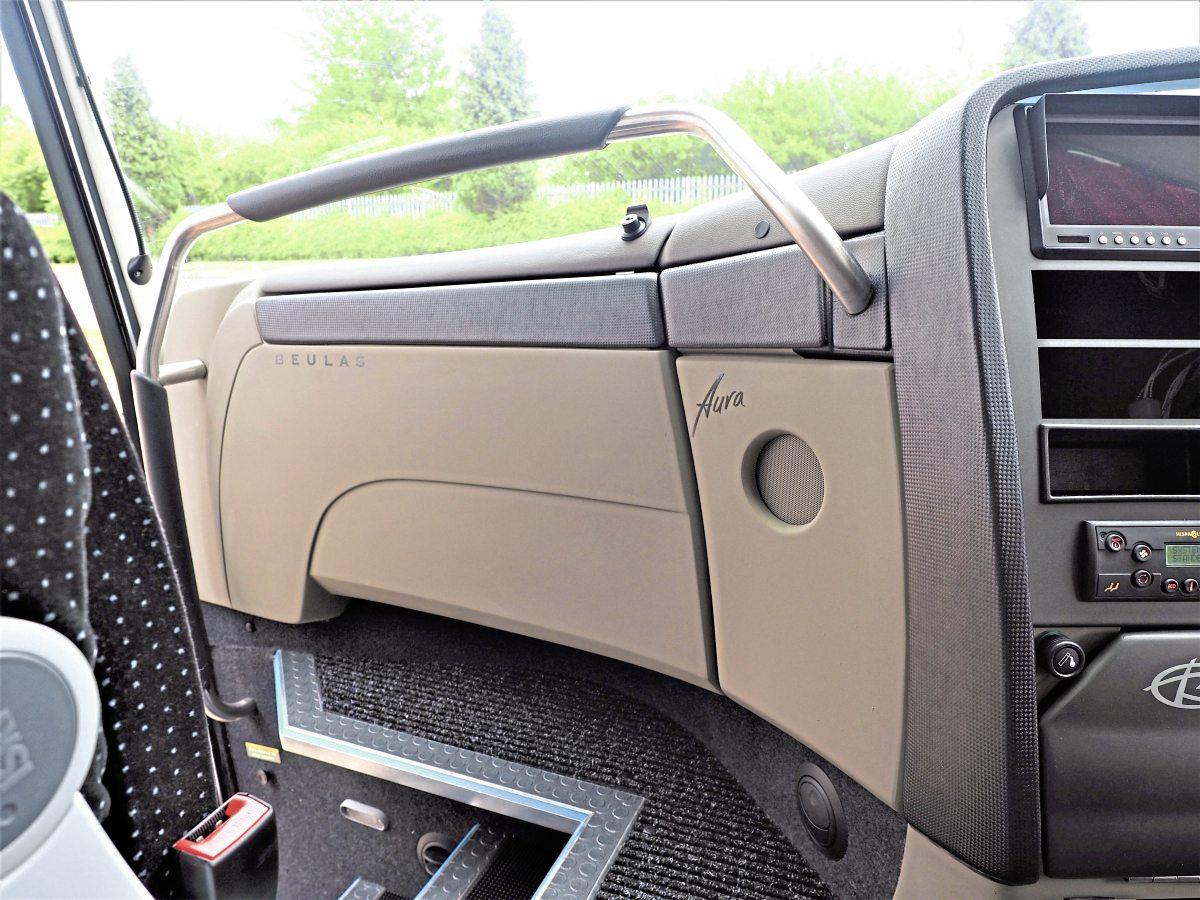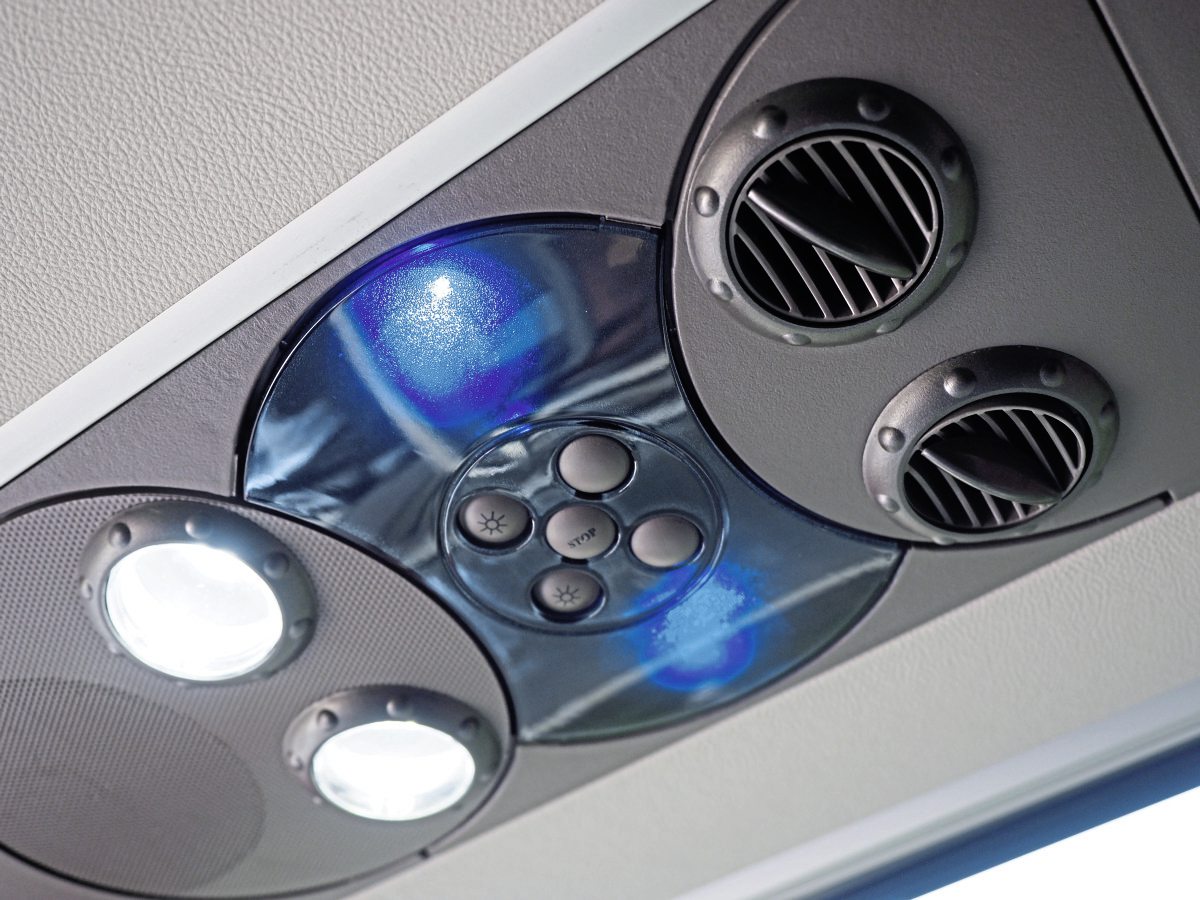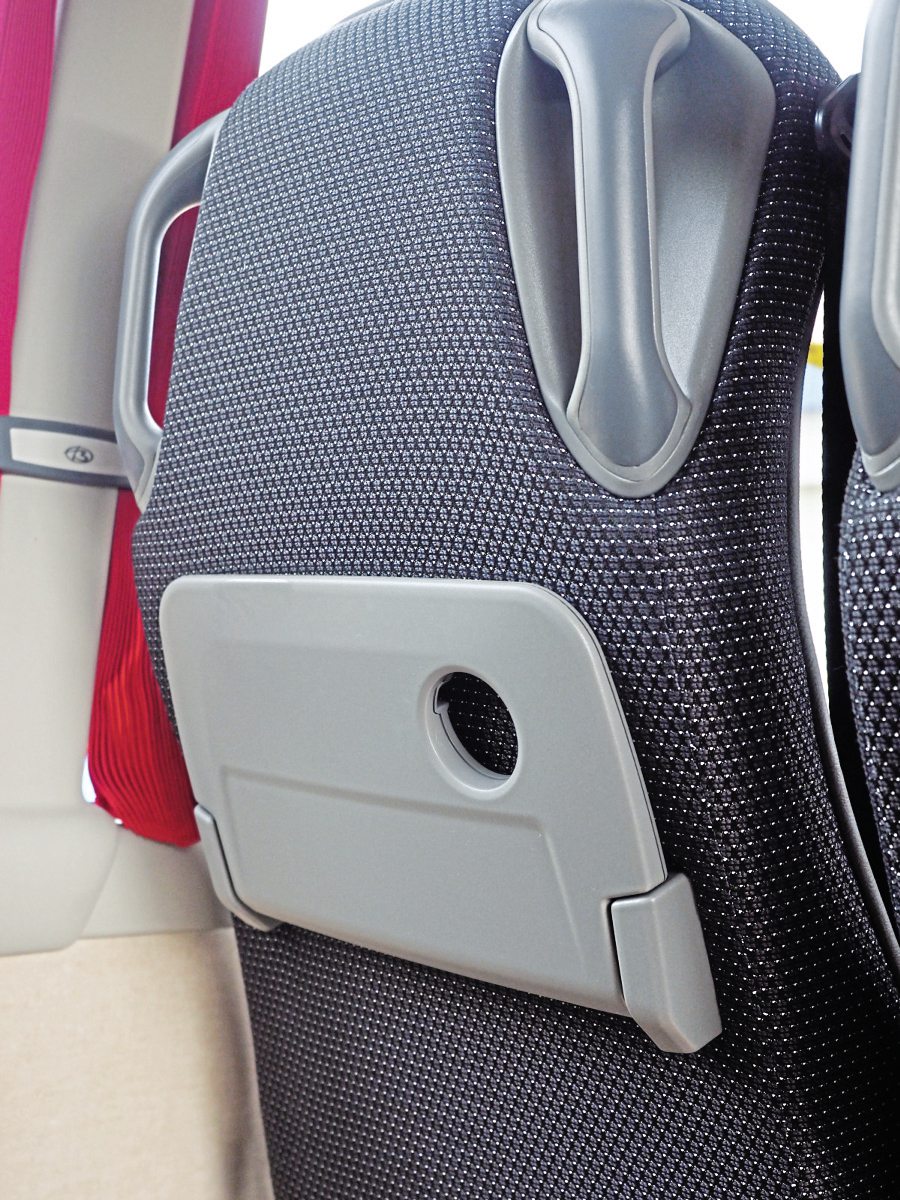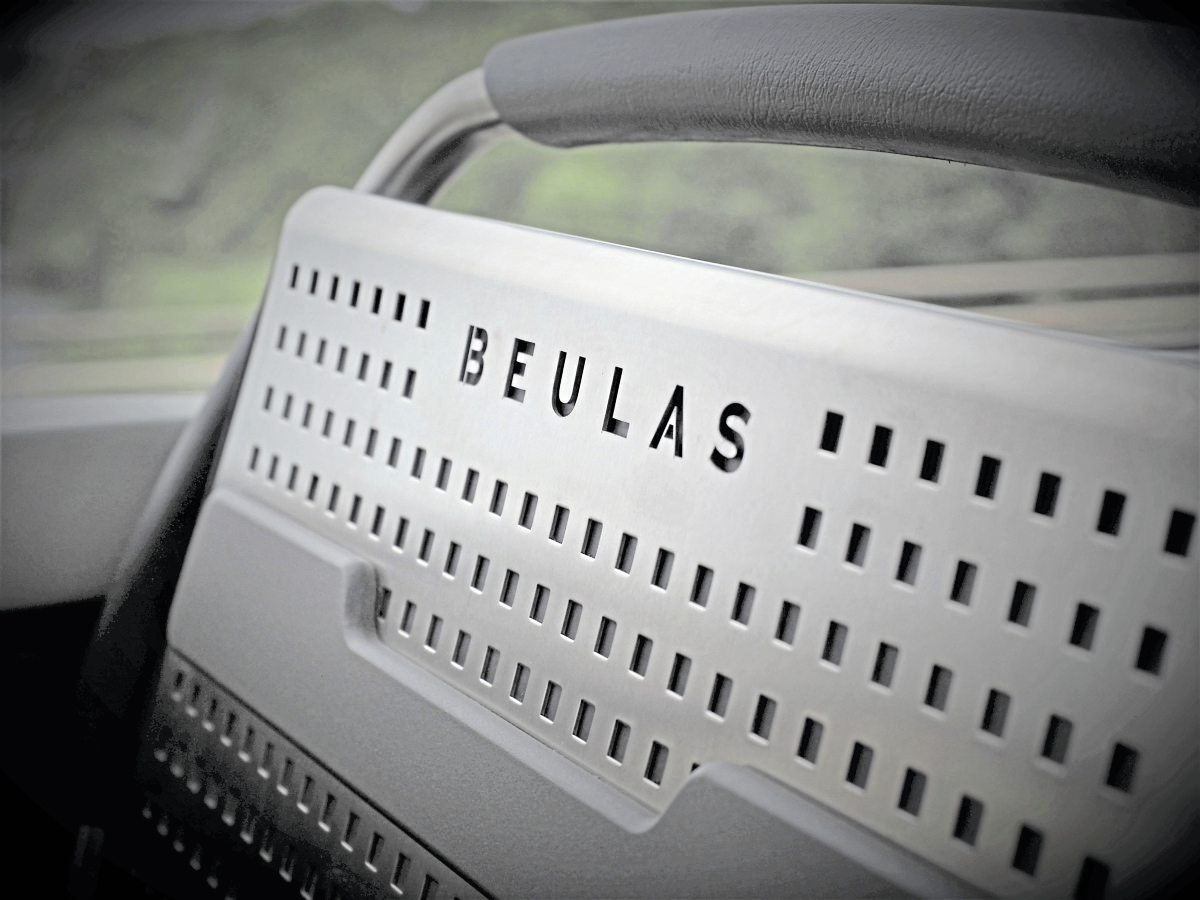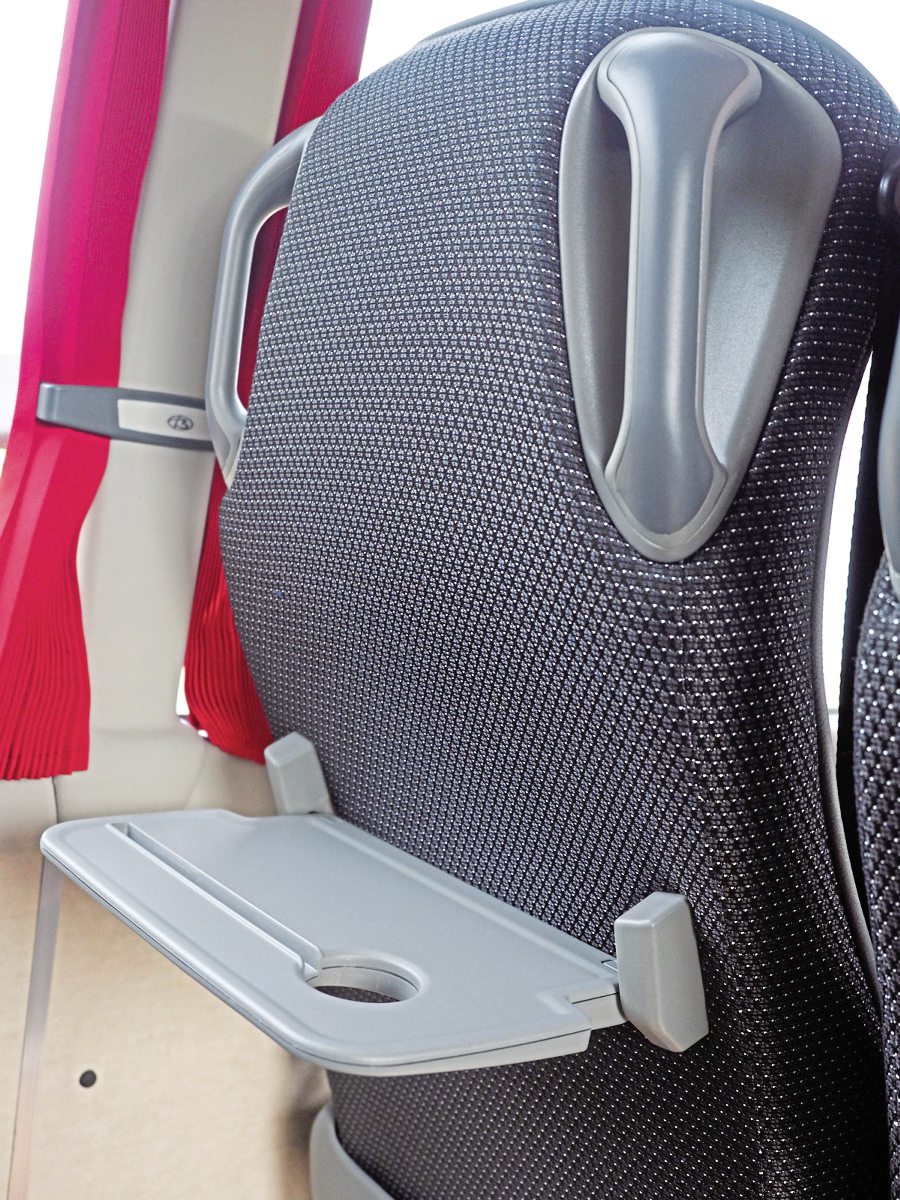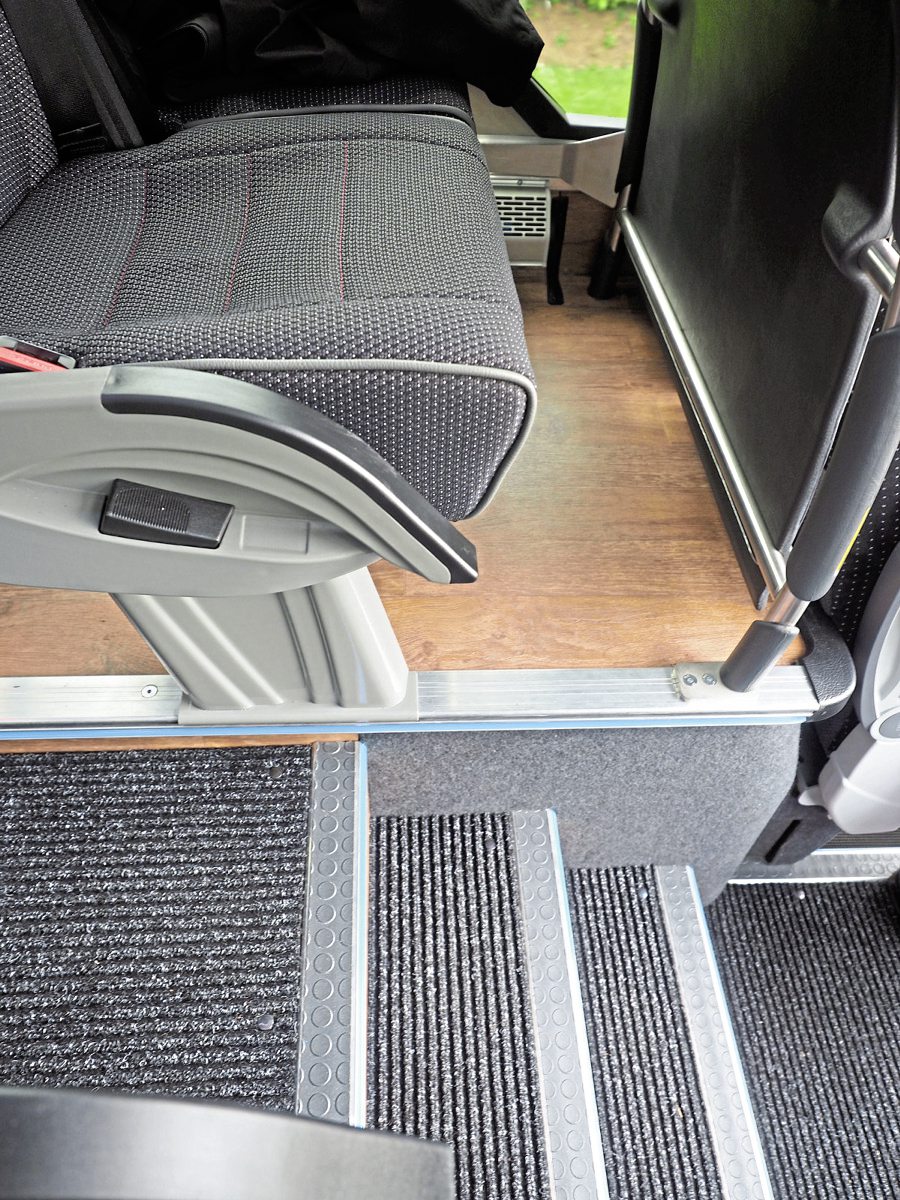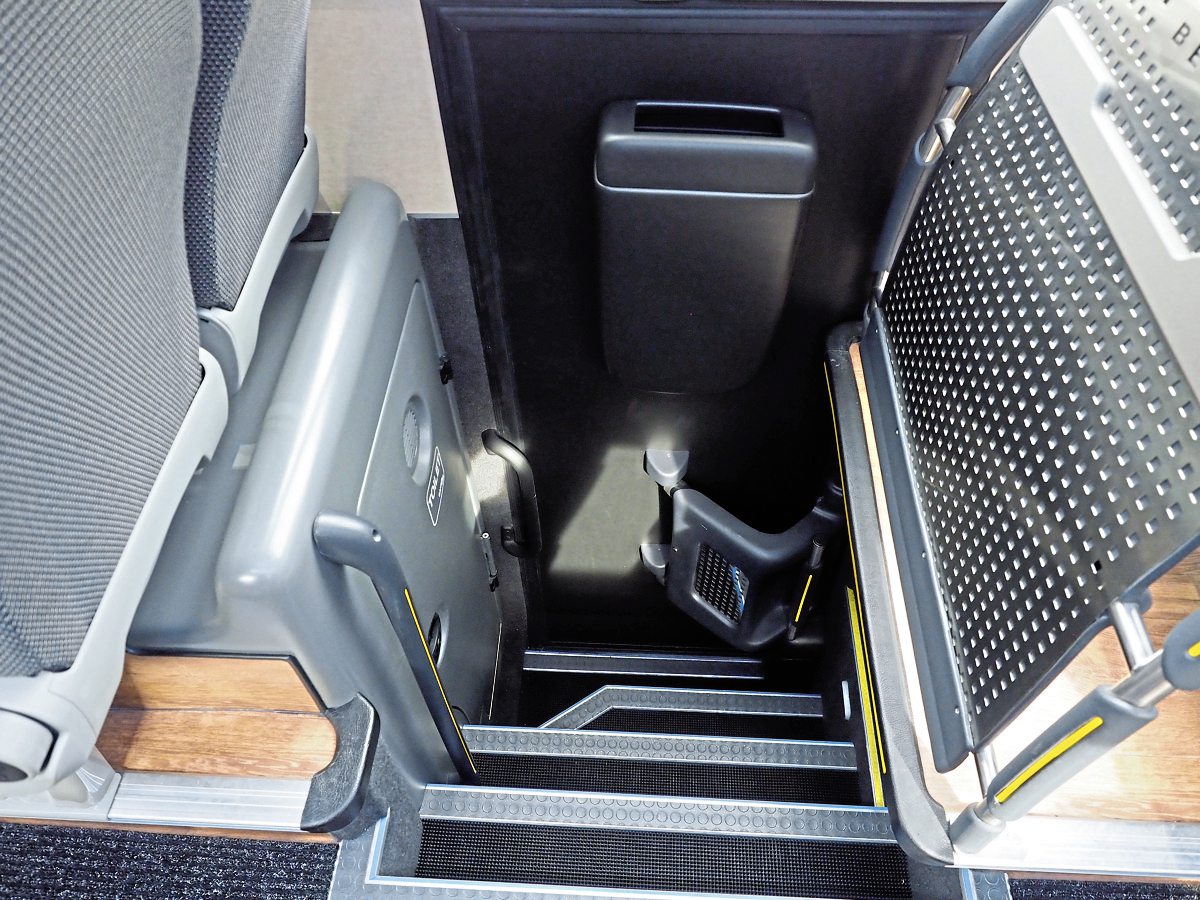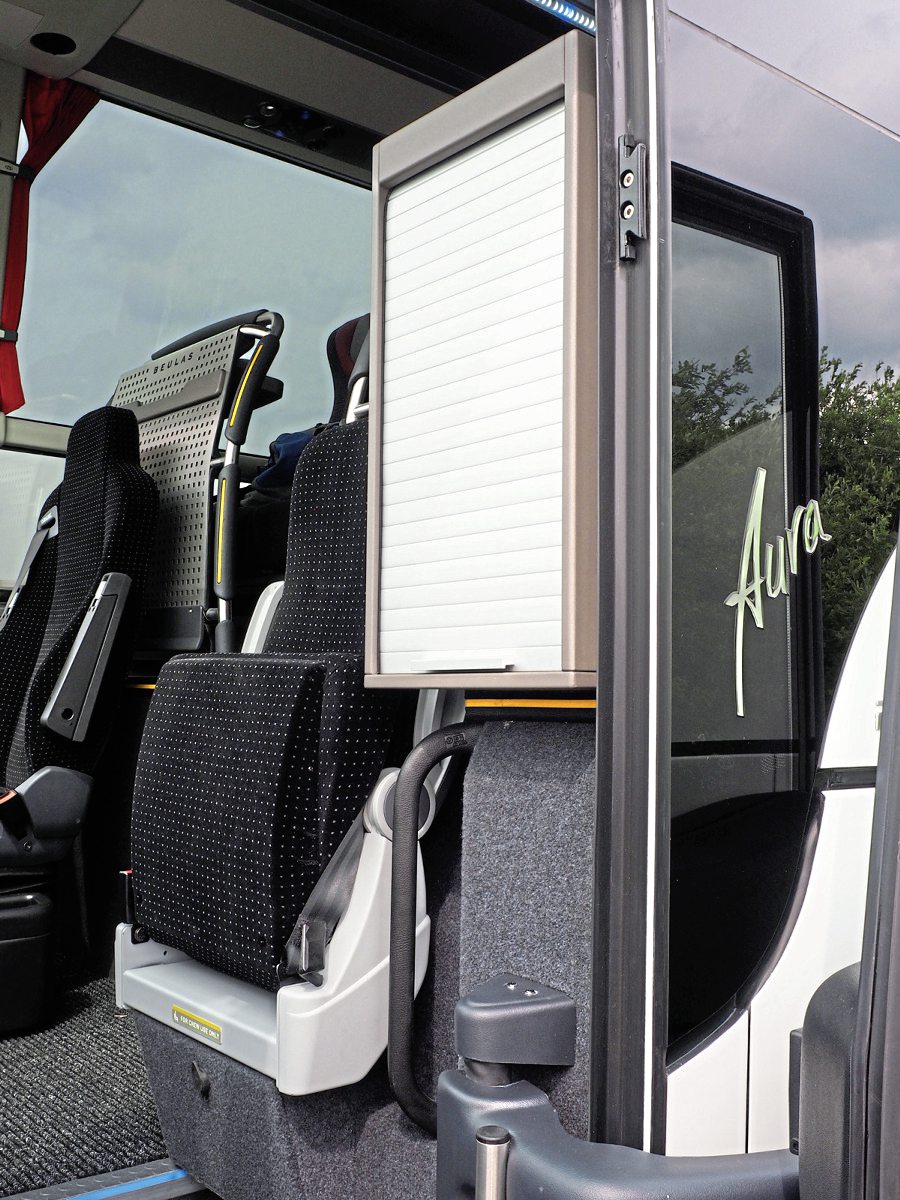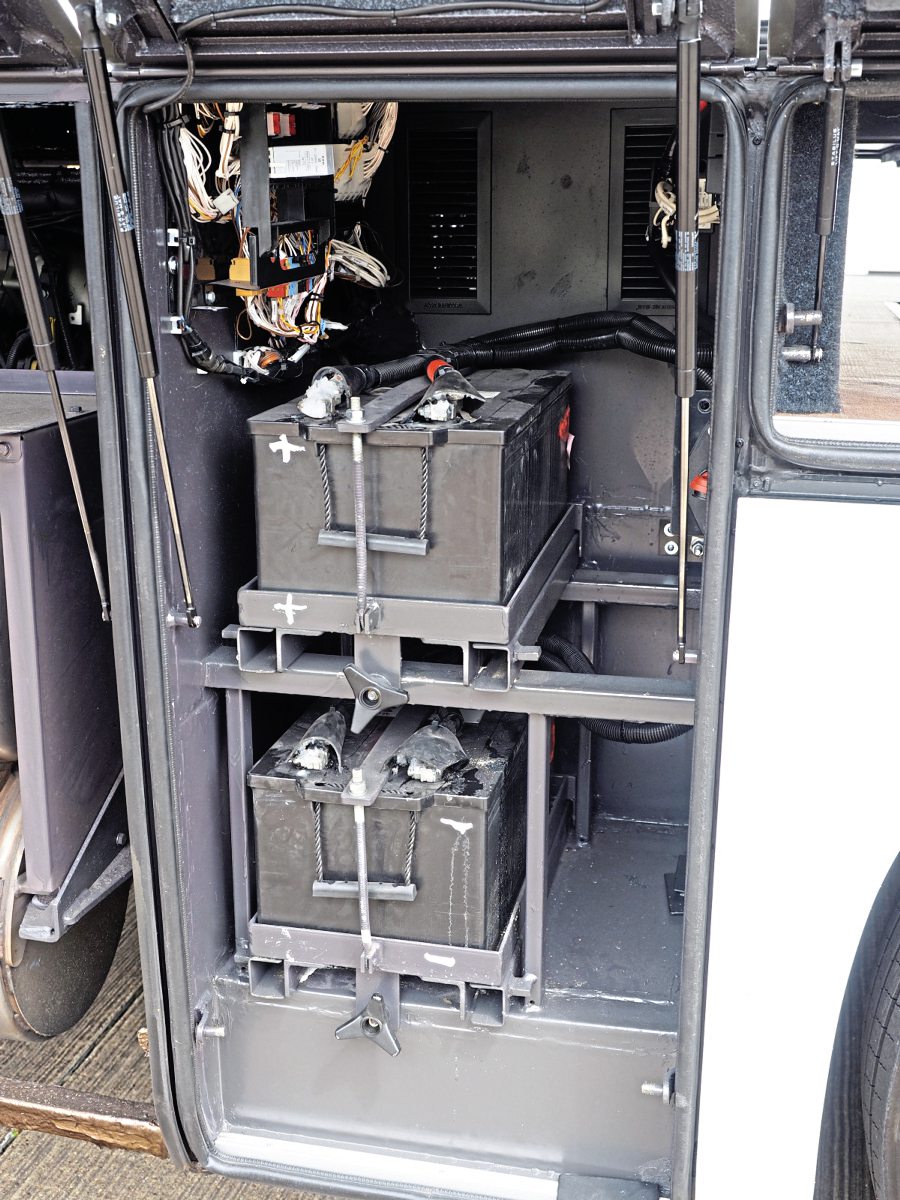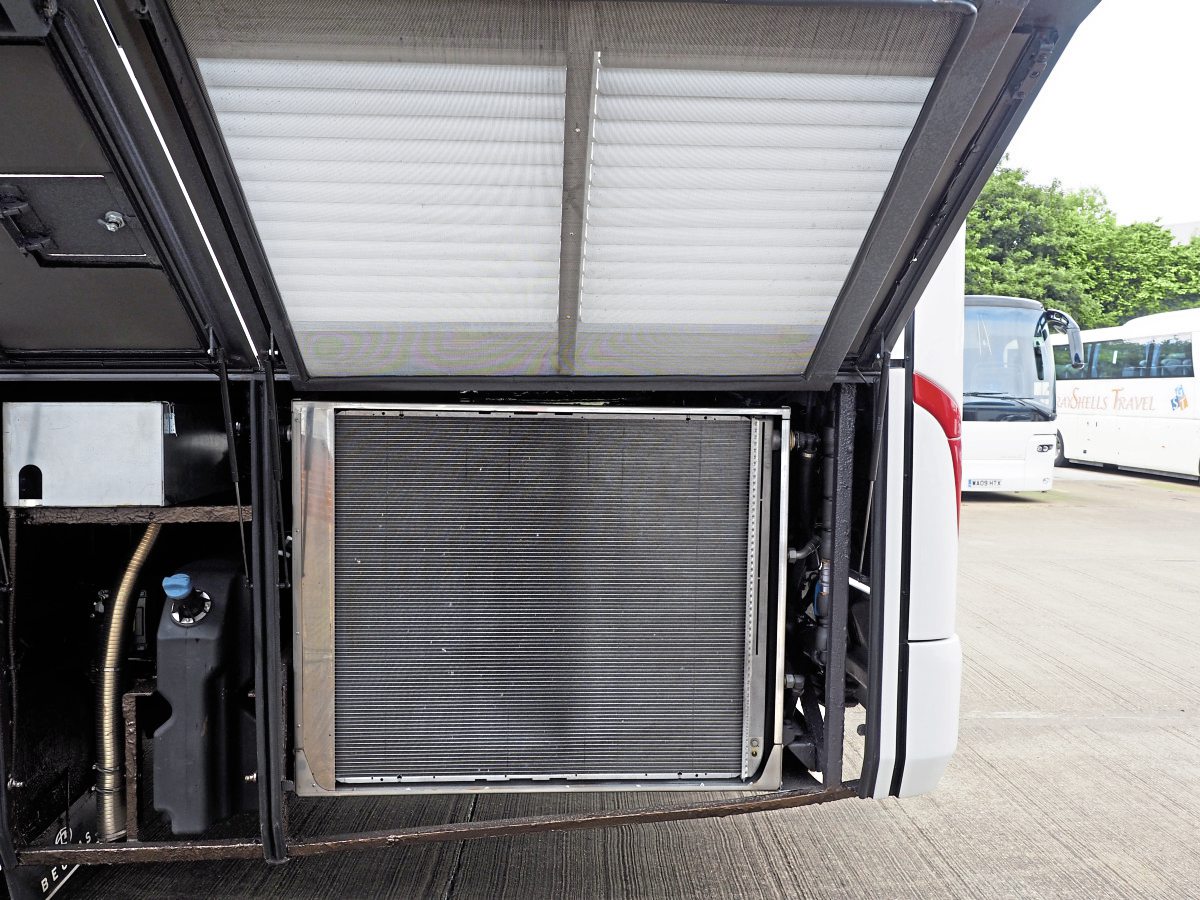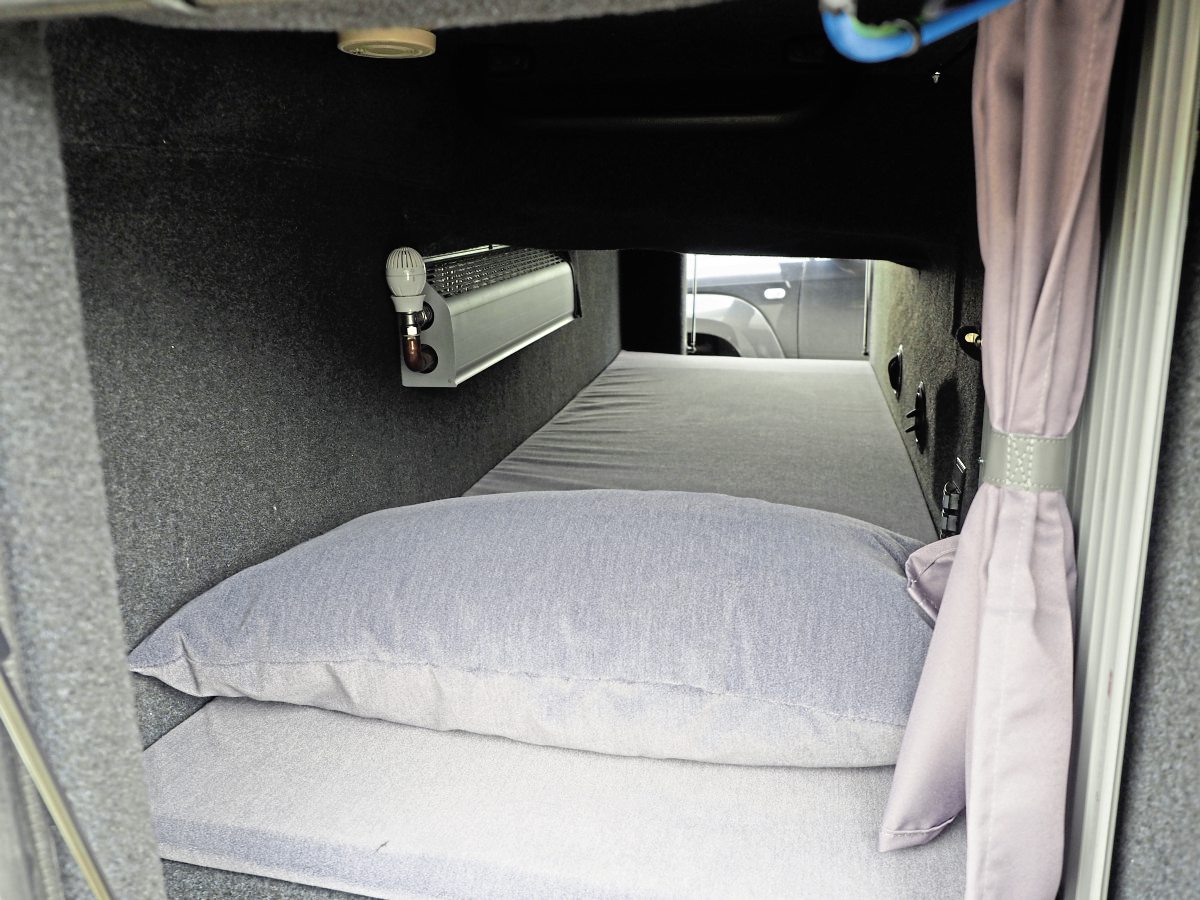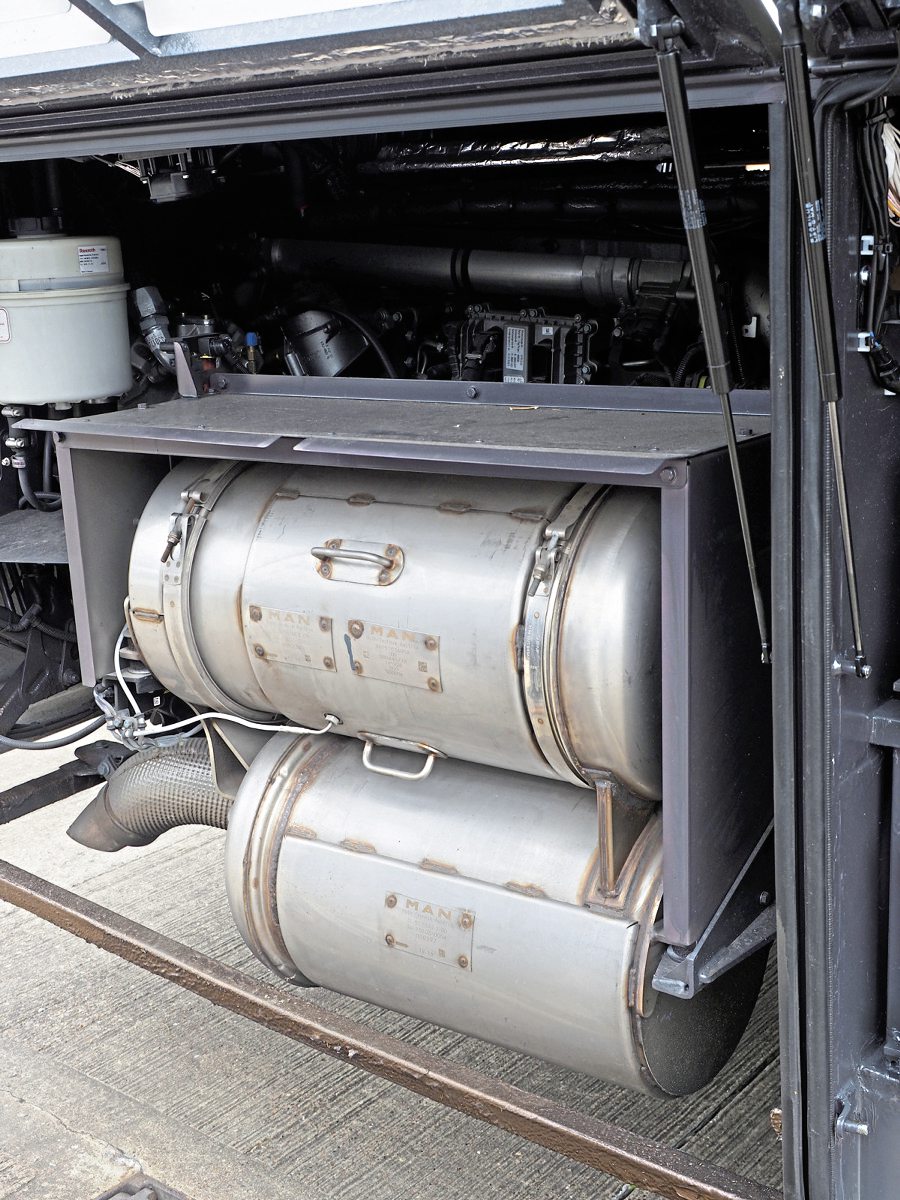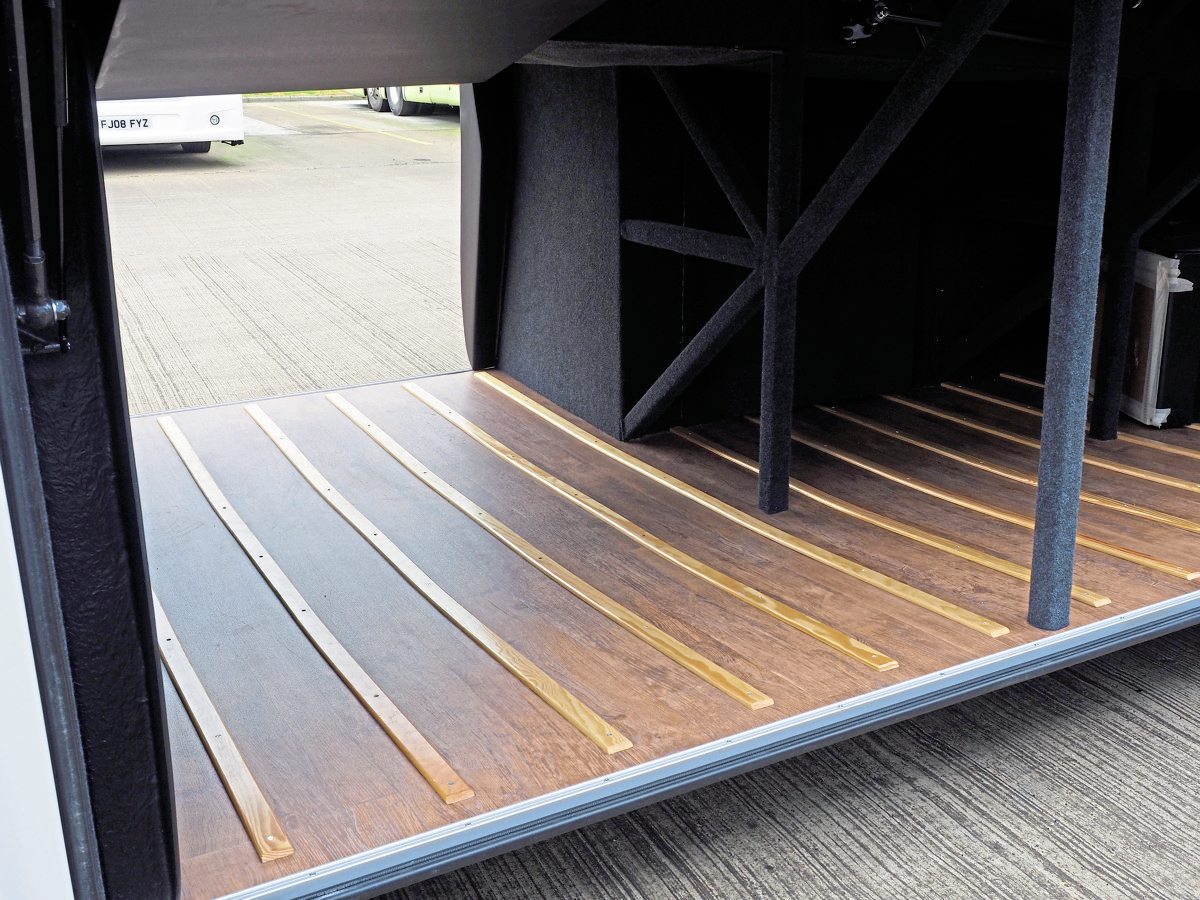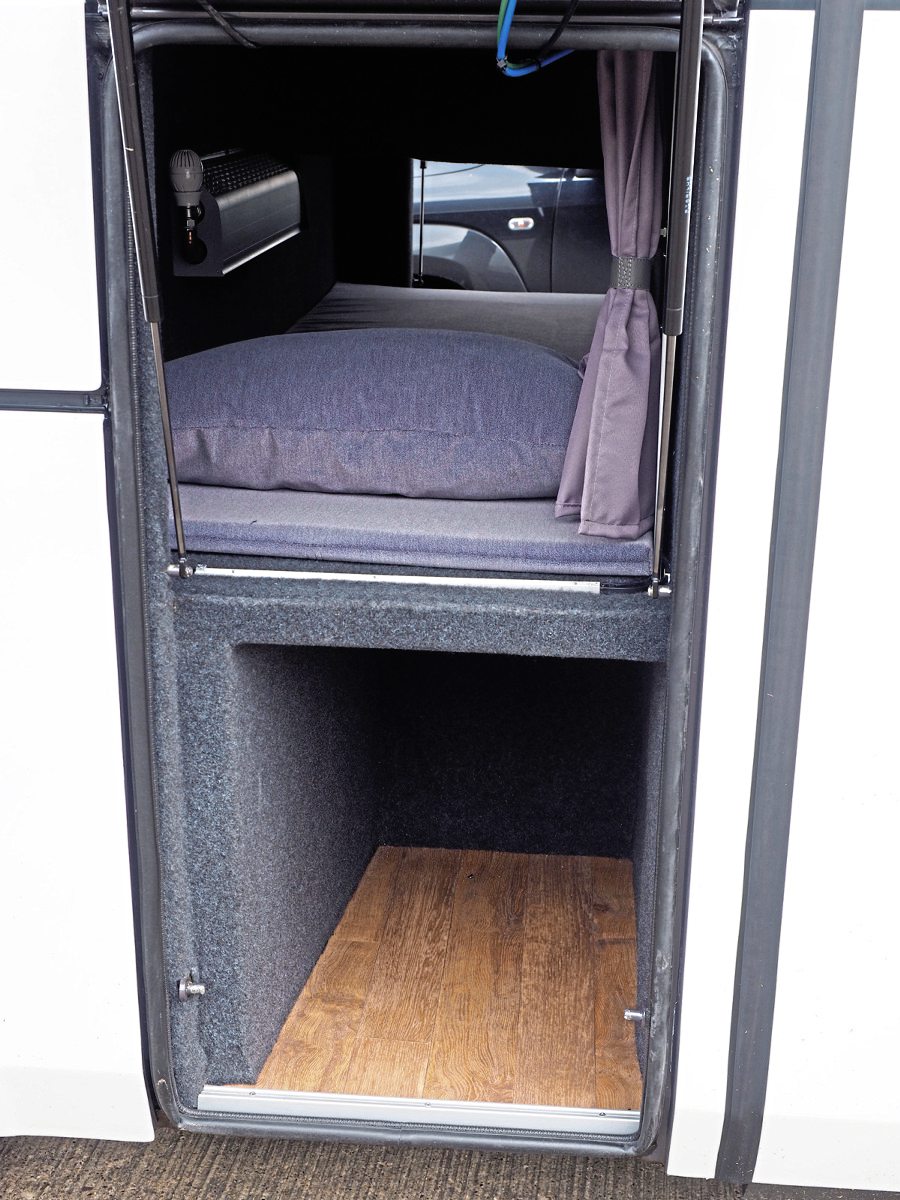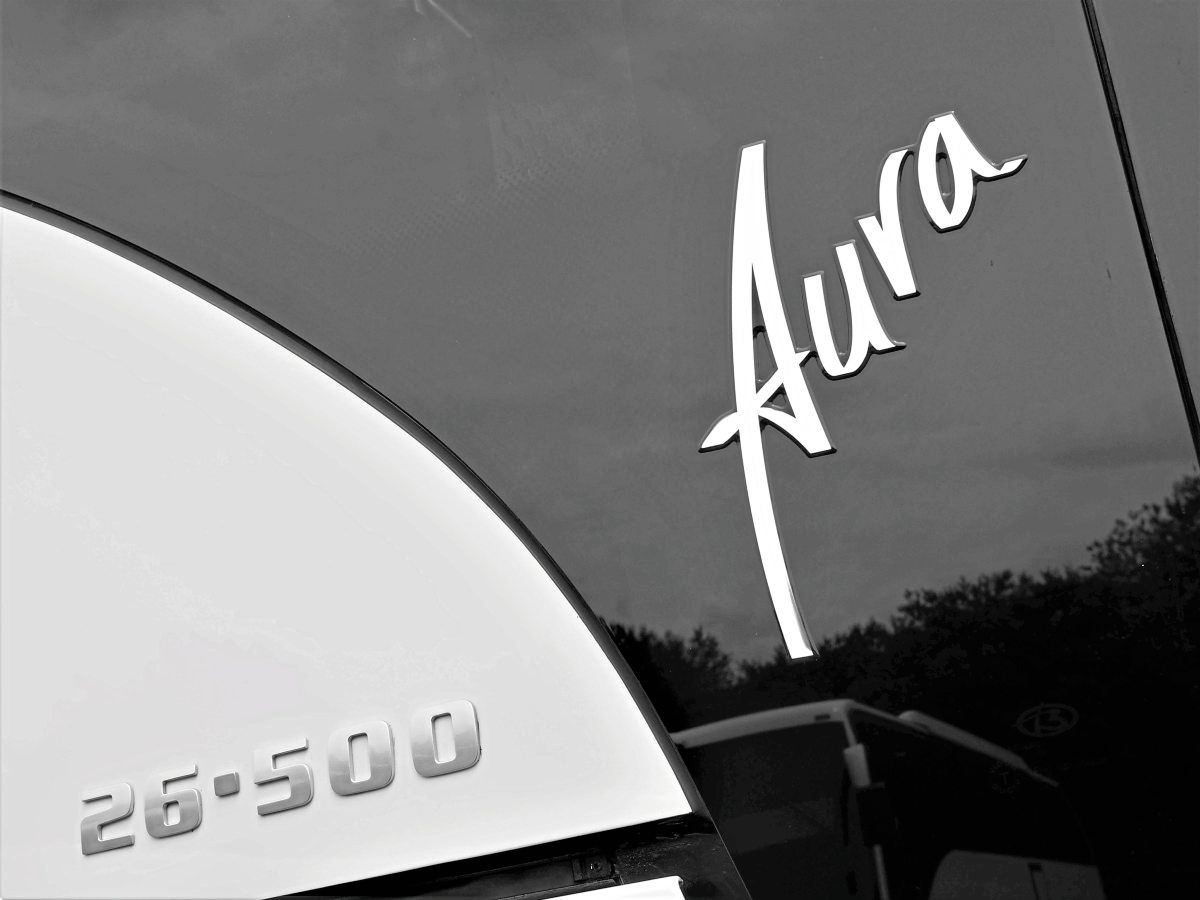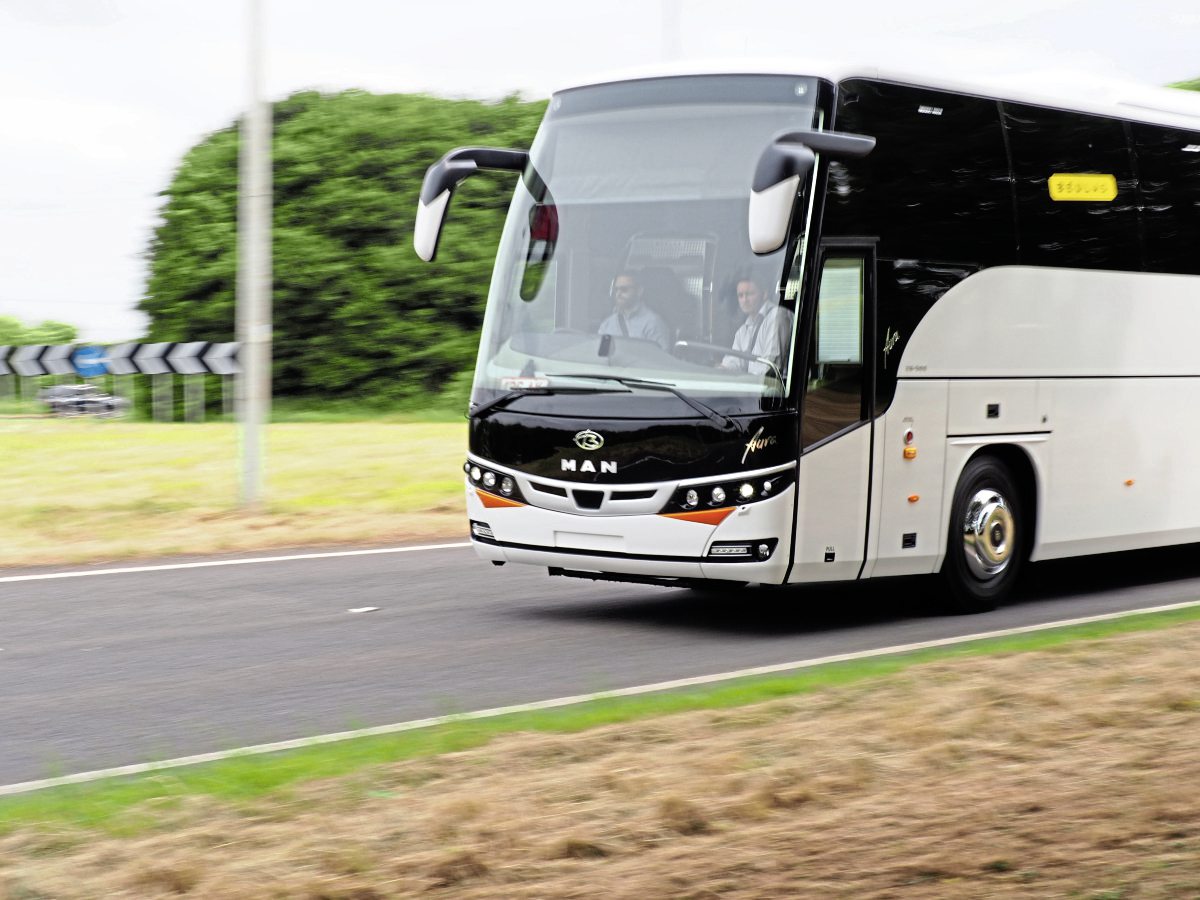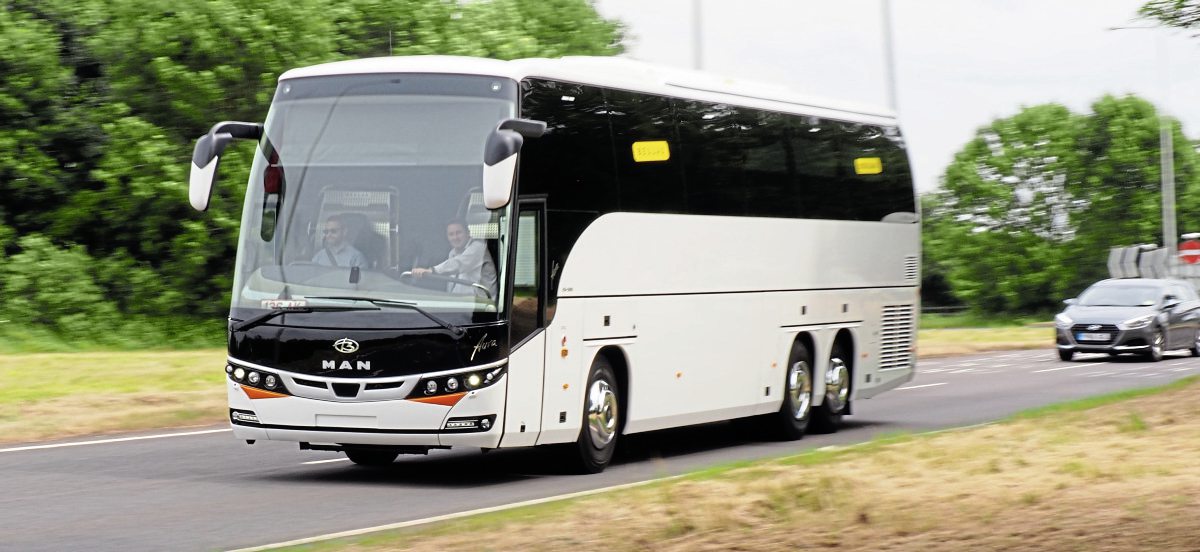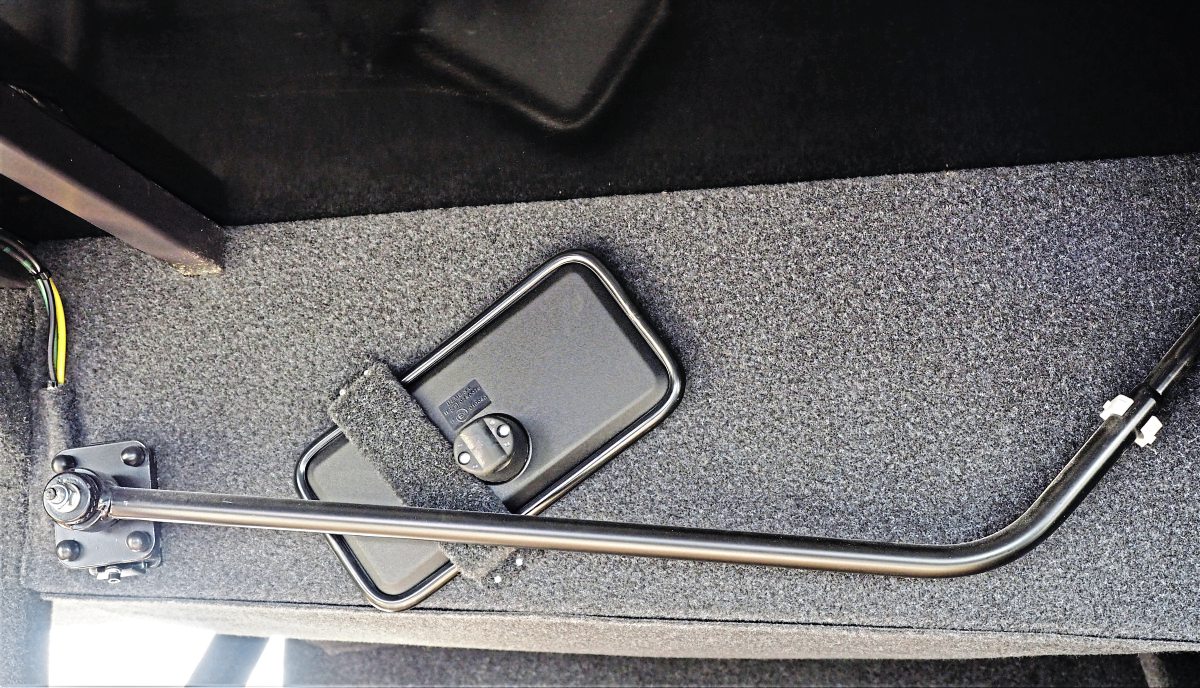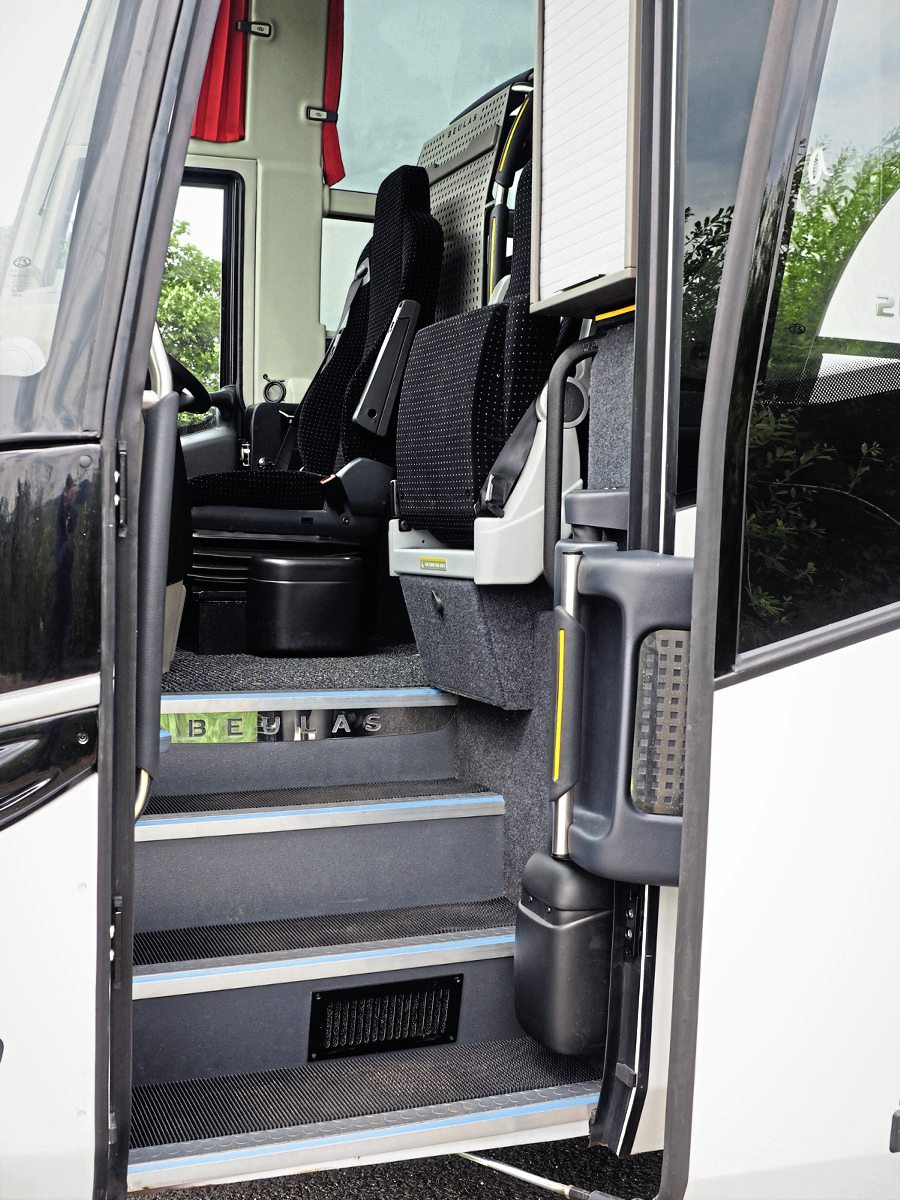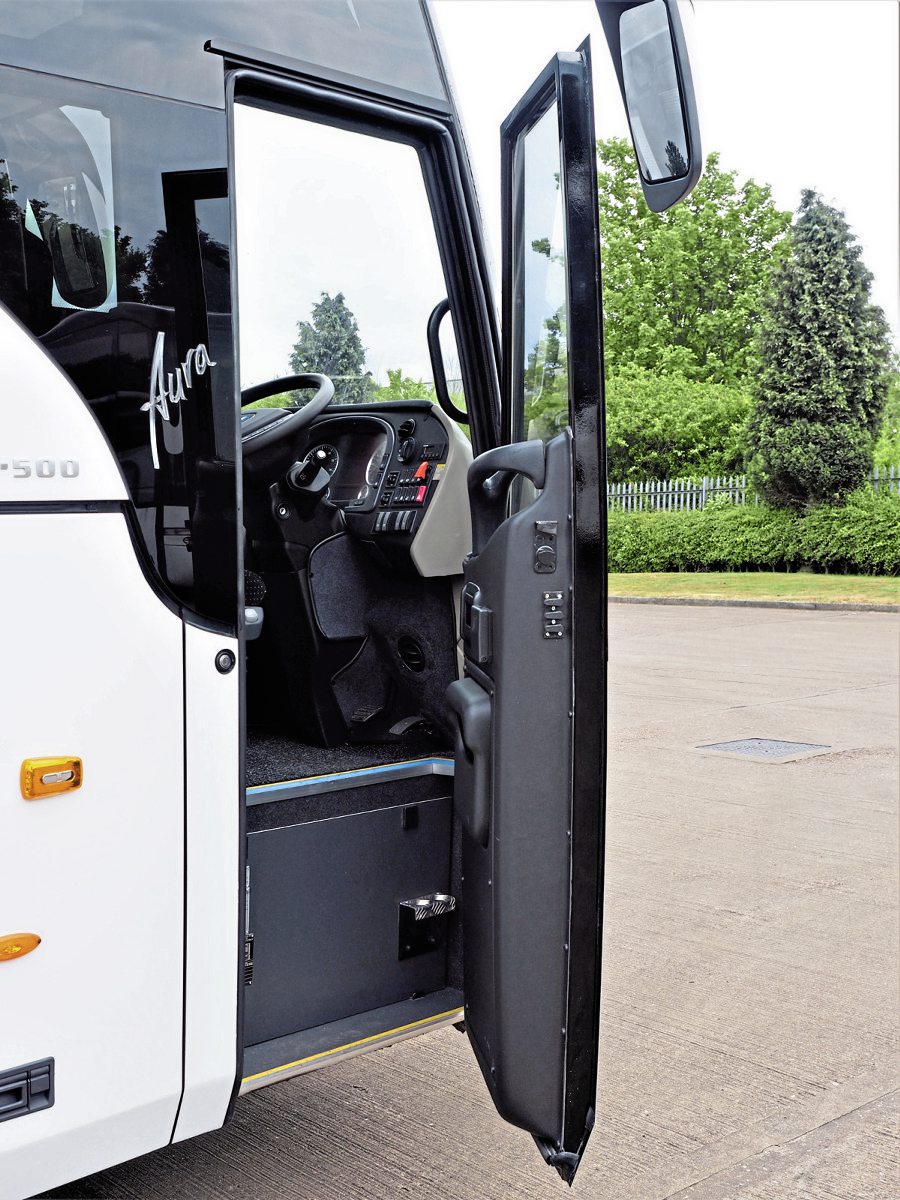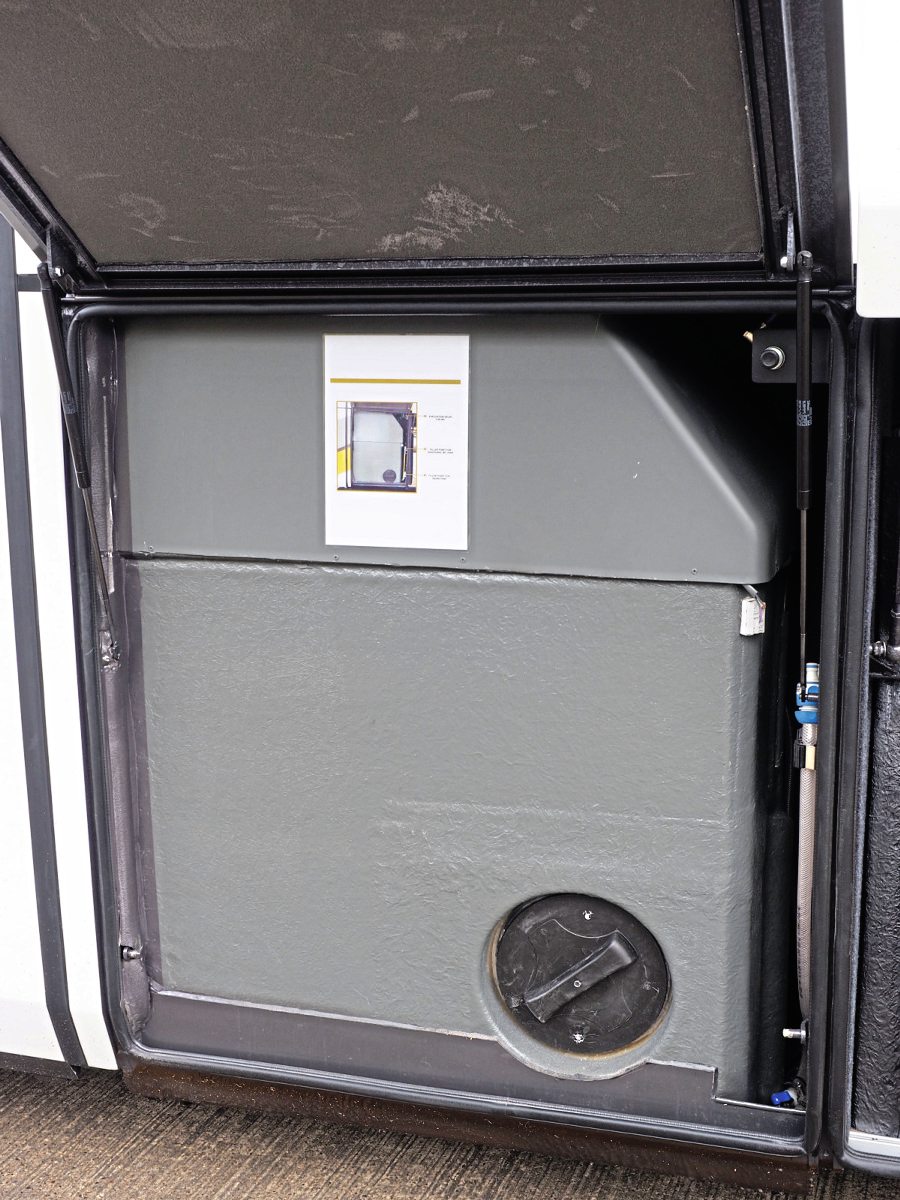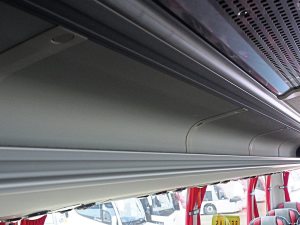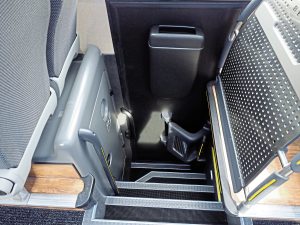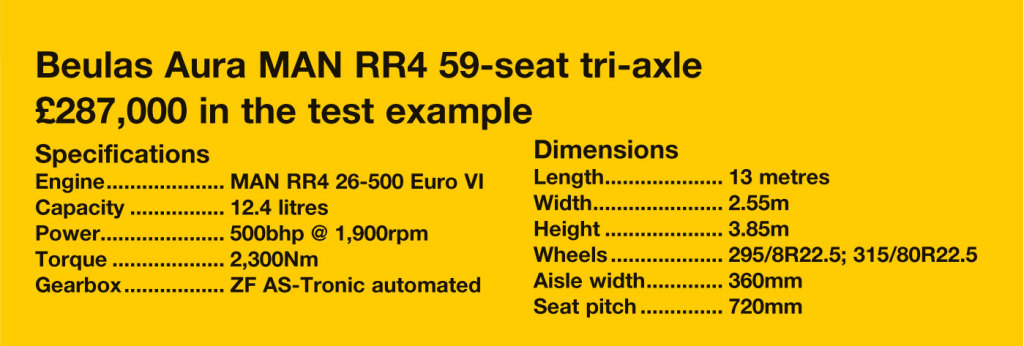Aura defined
The dictionary says: ‘Aura – the distinctive atmosphere or quality that seems to surround and be generated by a person, thing, or place.’
Does Beulas’ Aura with the powerful MAN 500bhp chassis possess any ?
Out on the road, it’s obvious within a few miles that Beulas’ Aura with MAN’s RR4 tri-axle chassis is every bit a driver’s machine.
The 26.500 chassis with 500bhp and enough torque to pull up trees barely gets out of breath as we traverse the roads around Moseley PCV’s Pontefract base. Bus & Coach Buyer’s driver for the day points down at the instrument binnacle; we’re sitting on the limiter, yet the engine is at a shade over 1,000rpm.
Indeed, for the entire afternoon, it was rare to see more than 1,500rpm on the tacho and, with ZF’s AS-Tronic automated 12-speed gearbox, hard to detect the gear changes; maybe a slight hesitation on a hill climb, but the digital gear indicator offered more drama. Low revs in combination with Beulas’ rattle-free, solidly-built Aura body made for a very relaxing road test.
Coaches aren’t cars, but you’d perhaps expect that having so much power on tap would give GT performance. In a sense, it does; Gran Turismo in its original form, when luxury car makers built luxurious, mile-hungry cars they reassured buyers it would allow them to traverse the Alps en route to Cannes in style.
This is a 59-seat touring coach of some merit. The question is, will those merits persuade you to buy one?
Exterior
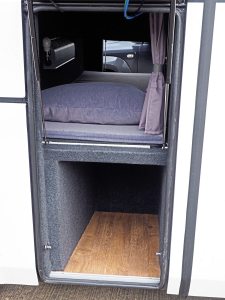
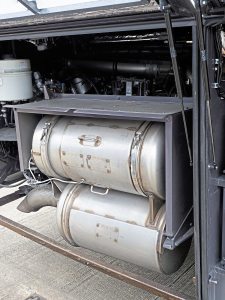
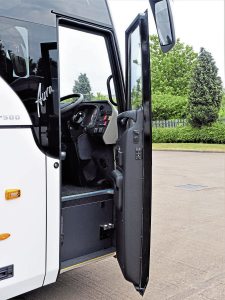
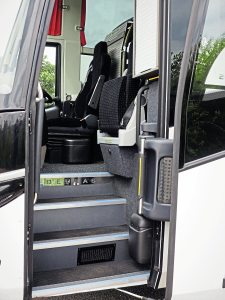 As a bodybuilder, Beulas has always been a master of understatement, producing coaches which, though beautifully proportioned, are timeless in their style.
As a bodybuilder, Beulas has always been a master of understatement, producing coaches which, though beautifully proportioned, are timeless in their style.
So it is with the Aura. Beulas has erred on the side of caution, avoiding excess in every area, but clearly focusing its attention on its quality and durability. This was evident at first glance.
I’m not, to be honest, a fan of white vehicles and though I understand why the demonstrator would be this colour (complete with ‘Beulas luggage labels’), the Aura is a vehicle which would benefit from a dark metallic; it’s a classy shape which would benefit from a classy colour.
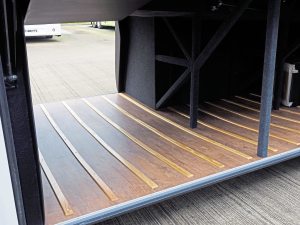 In the metal, it’s more impressive than my pictures. The fit of panels is very good and the general finish outstanding. Key Beulas styling features, such as the fold on lower panels, tucking under the coach, remain. The Hispacold air-con pod sits mid-roof making the front view look tidy.
In the metal, it’s more impressive than my pictures. The fit of panels is very good and the general finish outstanding. Key Beulas styling features, such as the fold on lower panels, tucking under the coach, remain. The Hispacold air-con pod sits mid-roof making the front view look tidy.
The windscreen is big, offering classy looks and a good forward view, though more glass to buy if it gets damaged. Beneath the screen is a nicely accomplished lighting cluster and in the front valance additional driving lights. Mirrors are standard ‘Gromit ear’ items.
Glass at the side begins with a large, complex pane which covers the B pillar, and another pane beneath it which, though behind the seat, offers a side-rear view for the driver. Down the nearside are five identical double-glazed panes and a further rear pane. The rear screen sits above a louvred panel above the engine bay doors, neatly curved rear light lenses let into the corner panels. The engine bay door offers a great space for branding messages.
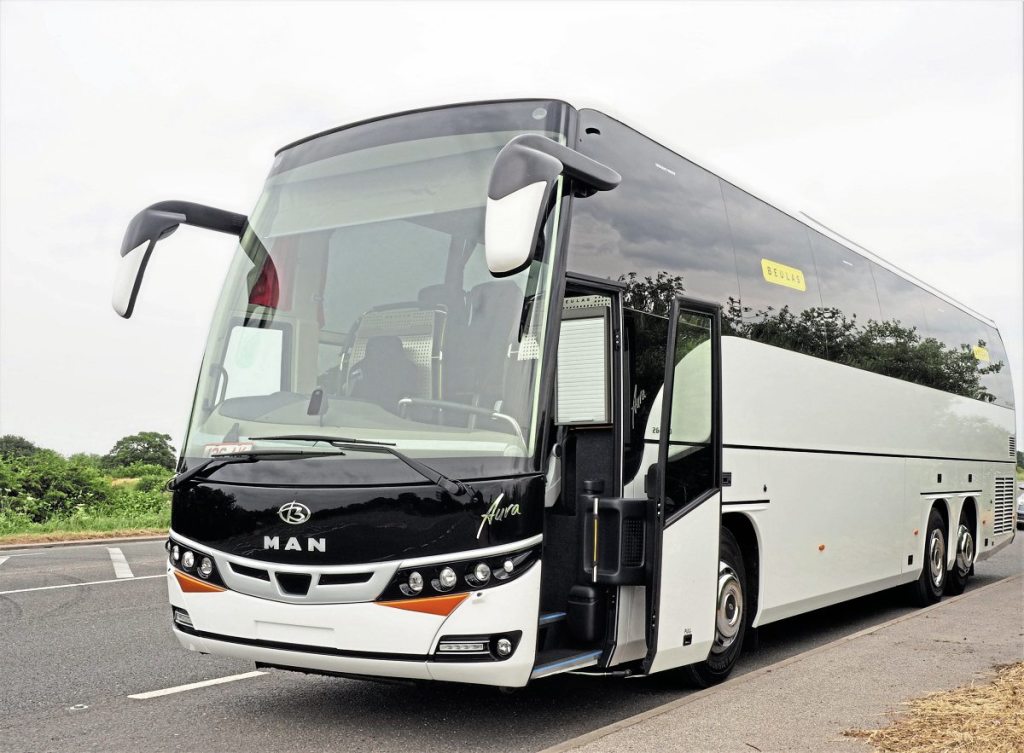 On the offside, unusually, is a driver door, followed by access to a variety of luggage lockers and a driver bunk (on the test vehicle), and of course the centre passenger door. The powered luggage lockers include one main, wood-floored locker, a number of ‘cubby holes’ plus a very large ski locker above the rear axles. The ski locker is very useful, with no ‘lip’ for luggage handlers to cope with.
On the offside, unusually, is a driver door, followed by access to a variety of luggage lockers and a driver bunk (on the test vehicle), and of course the centre passenger door. The powered luggage lockers include one main, wood-floored locker, a number of ‘cubby holes’ plus a very large ski locker above the rear axles. The ski locker is very useful, with no ‘lip’ for luggage handlers to cope with.
The main locker has an emergency mirror clipped into it and the ‘goody bag’ contained a few useful bits including a rather nice torch.
There is no exterior locker door closer switch, though Moseley says this can be added in the factory. The crew bunk can, of course, be converted to additional luggage space though at a claimed 11.5m3, only luggage-heavy groups like cruise passengers would present a problem.
The nearside has additional locker access and the cooling pack, with a radiator cover equipped with a debris screen, cleverly mounted to the cover door rather than the radiator itself. Nearside radiator matrices are vulnerable to getting cluttered by roadside debris kicked up, so this thoughtful touch will be valued.
There are service lockers for the twin batteries and electrics, for the AdBlue tank, for the waste water tank (with clear instructions to avoid toilet drop accidents!) and for the DPF and SCR units, which are stacked and fairly small for such a big Euro VI engine.
The passenger door is ample in width, with four steps – the top one with a reminder of the manufacturer in chromed metal – to the driver level and an additional three to the aisle. It has lighting overhead. The test vehicle had carpeted steps and aisle, though beneath was wood-effect flooring.
Interior
Inside the entry door, the tip-up courier seat has a paperwork locker beneath, footrest in front, and there are handrails to right and left. On the left, a large moulding panel sports the Beulas name – and the moniker is liberally featured throughout the coach, including on curtain tie-backs – while two large brushed stainless panels on the decency screens have the name perforated into them, with grab rails above.
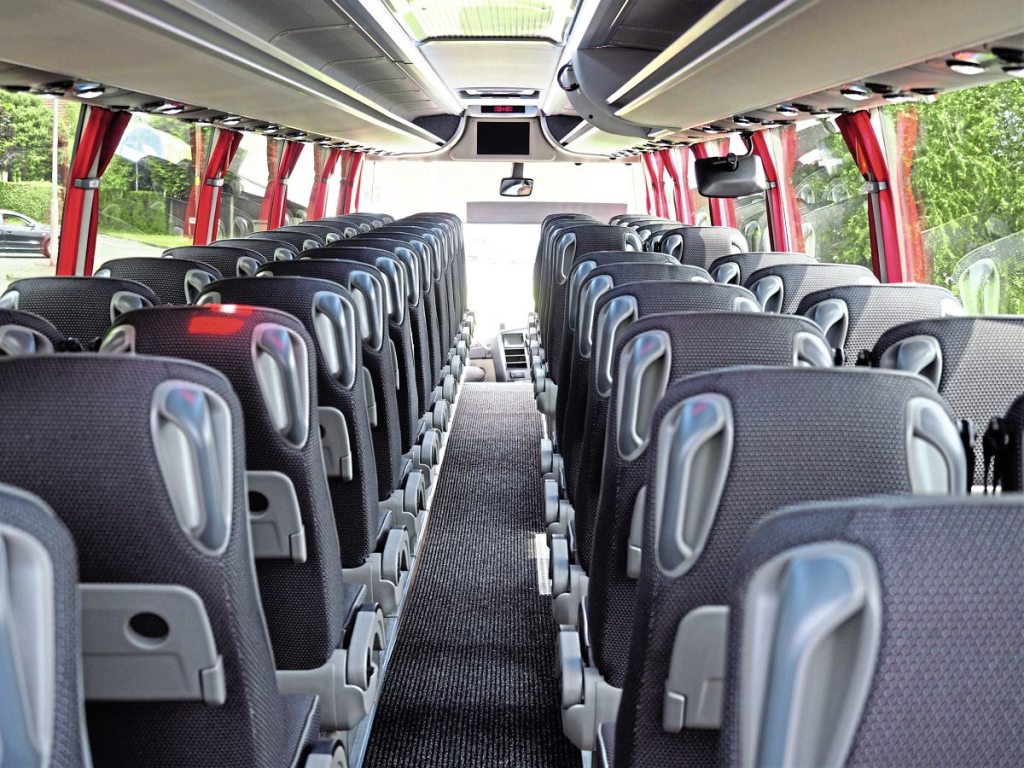 To the left of the courier, just inside the passenger door, is a roll-front cabinet containing the hot water dispenser and drinks storage. The use of the low-level toilet on which a pair of seats sits means there’s no centre servery. For some operators, this may not be the ideal arrangement but it helps achieve the seating capacity… depends on your priorities.
To the left of the courier, just inside the passenger door, is a roll-front cabinet containing the hot water dispenser and drinks storage. The use of the low-level toilet on which a pair of seats sits means there’s no centre servery. For some operators, this may not be the ideal arrangement but it helps achieve the seating capacity… depends on your priorities.
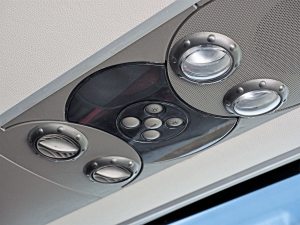 From the driver level, there are two further, shallow steps up to the aisle. The 360mm-wide dropped aisle is unusual in that it dips deeper in the centre and rises again to the rear. There is a final step to the rear rows of seats. Aisle nosings are alloy with a blue inlay. There’s a slight hazard at the nearside front seats, which drop to the second aisle step – just a small risk of passengers attempting to step into the aisle expecting a short drop but stepping into the void unexpectedly.
From the driver level, there are two further, shallow steps up to the aisle. The 360mm-wide dropped aisle is unusual in that it dips deeper in the centre and rises again to the rear. There is a final step to the rear rows of seats. Aisle nosings are alloy with a blue inlay. There’s a slight hazard at the nearside front seats, which drop to the second aisle step – just a small risk of passengers attempting to step into the aisle expecting a short drop but stepping into the void unexpectedly.
Seats are Sege VIP Sultan recliners, with armrests, seatback tables and on the test example, a modern moquette with leather headrest and piping. They are very smart, and have 720mm seat spacing providing adequate legroom for most groups.
The wood-effect flooring is neatly curved up to the convector heaters, leaving no dust traps. The centre door is accessed down a narrow stairwell with four fairly steep steps, and the entrance to the low-positioned toilet is fairly tight. The Sanibus toilet itself, though, is a quality unit which would be easy to clean. Above the toilet stairwell, there’s a mirror so the driver/courier can monitor it.
Over each row of seats are full-length racks, without sectional dividers except over the centre stairwell. The racks can be specified with doors. Adjacent to the centre stairwell is a position for a second media screen but, as I have said, on this pre-PDI example, the screen was not yet fitted.
The overall ‘feel’ of the saloon is that it’s bright and airy, thanks in part to the lack of excessive privacy tint on the glass. The seats seemed a good match for the interior generally, with a quality fabric and the contrasting headrests for a bit of pizazz.
Driver cab
The test vehicle was a pre-PDI example which will be off to Autosound when the buyer has specified the media kit required. Hence the vacant spaces left of the dashboard and the absence of one or two electrical items.
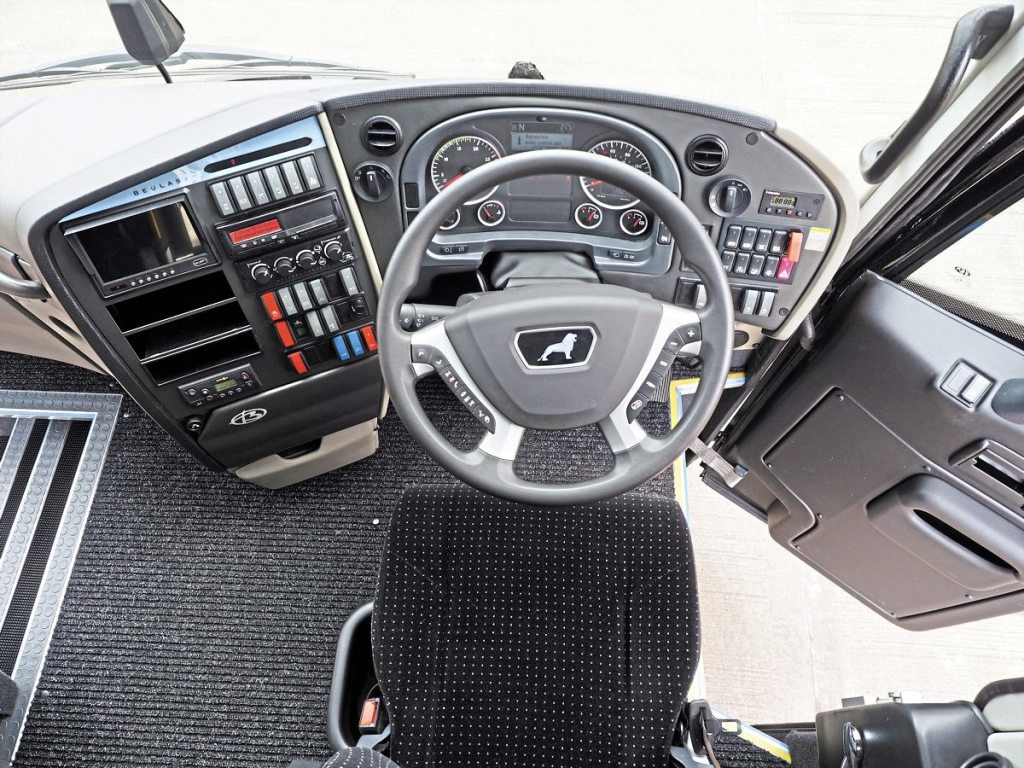 Perhaps due to the presence of the driver door, which prohibits creating a switch console to the right of the driver, the first challenge our professional driver had was finding the steering wheel adjustment (it’s under the dash to the right, by the way). From the Isri suspended driving seat, once the steering wheel was adjusted for our driver, two things became clear.
Perhaps due to the presence of the driver door, which prohibits creating a switch console to the right of the driver, the first challenge our professional driver had was finding the steering wheel adjustment (it’s under the dash to the right, by the way). From the Isri suspended driving seat, once the steering wheel was adjusted for our driver, two things became clear.
The first was that the tachometer was slightly obscured by the steering wheel, though the speedometer was in full view; the second was as he adjusted the mirrors via the toggle switch, that there is no separate low-level mirror. This posed him no particular problem. The view in both mirrors was very good, with no A pillar intrusion, and both mirrors visible through the swept area of the windscreen wipers. Our driver said this is not always the case. Some drivers may prefer an additional ‘line of sight’ mirror, and this can be specified at the factory.
The instrument clusters are very much standard for position and appearance on this MAN dashboard, with most of the vehicle controls to the right and the passenger-related switchgear on the left, together with a tachograph, climate controls for the Hispacold system, reversing camera screen and, low down, a small storage box.
There’s additional storage in the driver door and on the left of the seat at floor height, plus a dashboard fridge, mounted in front of the courier position. As you’d expect on a modern vehicle, controls for the cruise system and Bluetooth hands-free phone are on the steering wheel.
But let’s talk about that driver door for a minute. It’s undoubtedly a useful addition to a coach but like all things, it’s a compromise in small ways. Not only does it remove a useful switchgear position (or eliminate it if you don’t like them) but the dismount by a driver might be slightly ungainly, the descent aided by a chequer-plated step and, one would guess, a firm grip on the door handle.
To its credit, the door is a good fit with no wind noise or road rumble evident, and is double-glazed so unlikely to mist. Ignoring its presence is a perfectly reasonable option, because it has no impact on the driver area to speak of.
Driving
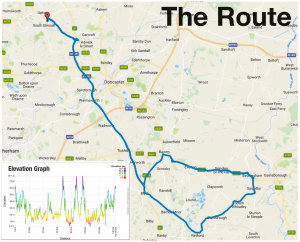 From the first time he took the wheel, our driver was very impressed with the way the Aura, with its powerful engine performed.
From the first time he took the wheel, our driver was very impressed with the way the Aura, with its powerful engine performed.
The coach wasn’t challenged by tight turns and manoeuvring, the steered tri-axle offering a slightly better turning circle than the equivalent two-axle coach, our driver said. Out on the A roads, things got even better.
The marriage of this 500bhp engine with the 12-speed AS-Tronic is a natural one, and the gear changes were perceptible but smooth: “This is very pleasant,” he said. “At first you think the engine is unresponsive because you unfairly expect peaky acceleration. What you get is very refined power, very understated, and faultless power delivery.”
The tachometer needle was hardly overworked, no matter how the coach was driven. Driven on the limiter at 100kph, the engine is at 1050rpm – barely above tickover for some coaches. Even driven fairly hard, the tachometer needle moved glacially within the green zone.
The test route took in no major hills but there were absolutely no doubts that even a severe hill would be taken in the coach’s massive stride. It’s a driver’s machine, without doubt.
The road-holding was excellent, helped by a steering wheel with just the right amount of feedback to the driver, never transmitting Nottinghamshire’s potholes and with a centring action that wasn’t too aggressive, as some are, said our driver. On good surfaces, the coach held its line perfectly with few corrections required.
The braking is linked to the four-stage intarder, and this too was very much to the driver’s liking, offering, with adjustment, a great blend to give passengers a smooth journey. And a smooth journey was what passengers can expect.
Although testing an unloaded coach will always be less than ideal, the driver’s experience was that the ride will be good, too. On the test, there was no ‘nodding donkey’ effect over road humps, and no tail-wagging at any point. In the passenger saloon, noise levels were negligible and the low-revving engine didn’t transmit any unpleasant booming sound to seats at the rear. Rattles were non-existent, underlining the care Beulas takes in the build.
Verdict
The Beulas Aura with MAN RR4 chassis is a class act, with a build quality for which Beulas has become well-known and a travelling environment which will please your customers.
In danger of sounding like a stuck record, it’s also a great drive, the powerful engine and auto-change gearbox a good combination and all challenges on the road swept up with aplomb. According to the vehicle’s computer, the accumulative fuel consumption was around 10mpg, but we’d expect this to improve as the engine loosens up.
The Aura, launched in 2011, is the kind of coach you wouldn’t buy from stock. In our view, most operators would get Beulas to delete the crew bunk to gain luggage space, and therein might be a small issue. This 13-metre tri-axle is a cubic metre or so behind some of the competition in luggage capacity and, with 59 seats, you’d want to be careful with the groups you carry.
Our driver, himself a coach operator, was full of praise for the vehicle’s performance and finish but said, in essence, that he couldn’t see why he’d buy one largely because of ‘kerb appeal.’ Beauty, though, is in the eye of the beholder. The operator who does see reasons to buy one will be getting a very fine vehicle from a respected coach manufacturer.
